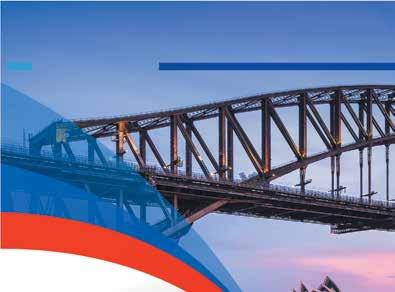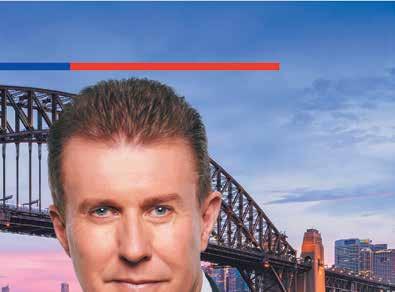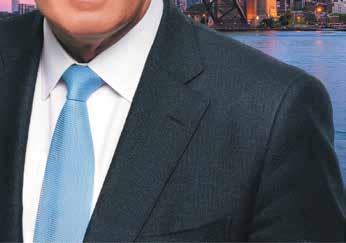

Sydney Harbour
What’s below the surface?
Captain Cook
A culture of music and dance
Cruising with COVID-19
Lockdown off Chile



Sydney Harbour
What’s below the surface?
Captain Cook
A culture of music and dance
Cruising with COVID-19
Lockdown off Chile
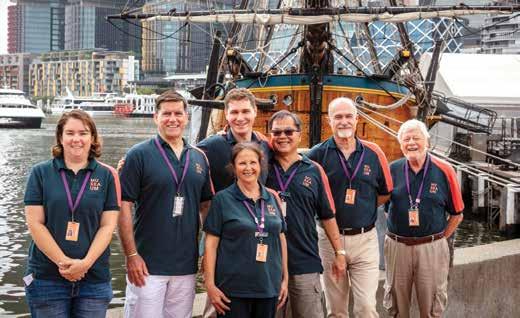
Volunteers give more than 60,000 hours of service per year to the museum, both at our Darling Harbour site and across Australia. Pictured (from left) are Bronwyn Fitz, Gavin Napier, Michael Ward, Merideth Sindel, Stephen Goh, Werner Obernier and Kel Boyd. Image Andrew Frolows/ANMM
SINCE OUR TEMPORARY CLOSURE IN MARCH, I have spent much time thinking about what the museum world will look like in a new age of social distancing. Our museum has enjoyed many years now of growing audiences, revenue and reputation. But what will the recipe for success look like going forward?
Traditionally, museums build reputations by excelling in four areas: curating unique collections, creating inspiring architecture and designing outstanding exhibitions, all of which are the creative and intellectual product of the fourth ingredient –passionate, dedicated and knowledgeable staff and volunteers. When blended together, these ingredients create truly memorable experiences for all our visitors. Without doubt we have expanded our collection, particularly in the Indigenous contemporary art arena, and acquired wonderful major pieces like the Bradley Journal and the magnificent SY Ena Architecturally we have enhanced Philip Cox’s masterpiece with a new foyer and Northern Gallery exhibition space and the award-winning Warship Pavilion by FJMT. We have had so many memorable exhibitions that it seems unfair to mention just a few, but my personal favourites have been Gapu-Monuk Saltwater – Journey to Sea Country, Bryant Austin’s stunning photographs in Beautiful Whale and the spectacular Escape from Pompeii: the untold Roman rescue. Wandering through the empty galleries while the museum is closed, it’s clear to me that there is still something missing other than visitors. What is lacking is that often-indefinable attribute which distinguishes one museum from another – or, in marketing jargon, our unique selling point. Some might say it’s the museum’s position on the water in Darling Harbour; others might point to HMAS Onslow or our replica HMB Endeavour. And while these are certainly vital ingredients, for me the museum’s unique spirit has always come from our staff and volunteers. The creativity, warmth, generosity and passion found in our galleries are a direct reflection of the makers and interpreters of these experiences.
So as I pass through our silent, empty foyer, I find myself smiling as I imagine again the hearty greetings, happy voices and warm invitations, particularly of our army of volunteers.
The museum’s 1,000-plus volunteers are based not just in Sydney, but right around Australia. All are ready to spring into action whenever Endeavour visits or when one of our travelling exhibitions lands in their home town. Every day 30 to 40 volunteers turn up at the museum to greet and inspire our visitors and, importantly, to carry out an enormous range of behind-the-scenes work. The museum’s volunteers are part of a massive army of more than six million volunteers across Australia who each year give their time, energy and dedication so freely to organisations like ours.
Each day begins the same for all of the museum’s volunteers, with an early-morning briefing. To listen to their banter, you know instinctively they are each other’s best friends, and sometimes much more – they are family. The chemistry, ribbing and hilarity are constant and an indelible part of the museum’s unique spirit. So as I look to the future and contemplate the museum’s reopening, it’s our wonderful volunteers that I most look forward to seeing and hearing again.
Kevin Sumption psm Director and CEOFor information on how COVID-19 has affected the museum and its events, and for details about online exhibitions and programs, please see pages 28 and 44–48.
Acknowledgment of Country
The Australian National Maritime Museum acknowledges the Gadigal people of the Eora nation as the Traditional Custodians of the bamal (earth) and badu (waters) on which we work.
We also acknowledge all Traditional Custodians of the land and waters throughout Australia and pay our respects to them and their cultures, and to elders past and present.
The words bamal and badu are spoken in the Sydney region’s Eora language. Supplied courtesy of the Metropolitan Local Aboriginal Land Council.
Cultural warning
People of Aboriginal and Torres Strait Islander descent should be aware that Signals may contain names, images, video, voices, objects and works of people who are deceased. Signals may also contain links to sites that may use content of Aboriginal and Torres Strait Islander people now deceased.
The museum advises there may be historical language and images that are considered inappropriate today and confronting to Aboriginal and Torres Strait Islander peoples. Number 131
Cover Discarded motorbike in Cabbage Tree Bay Aquatic Reserve, Sydney. Image Justin Gilligan
2 Submerged secrets
Sydney’s thriving waterways
10 Stories of migrants and members
Membership and Foundation news
14 Tasmania’s spotted handfish
Ceramics and science collaborate to save an endangered species
20 Cruising with COVID-19
A Member’s story of lockdown and escape
28 We’re reopening soon! A message from the museum
30 Dancing with Cook
Music and dance in Cook’s life and times
34 An eccentric curriculum
Crafting larrikins aboard the Nautical School Ships Sabraon and Vernon
42 ‘Not all beer and skittles’
Sydney’s marine pilots
44 Museum events for winter
Your calendar of online talks and family activities
46 Winter exhibitions
What’s online now and being planned for our reopening
50 Maritime Heritage Around Australia
Reconciliation Rocks, Cooktown, Queensland
54 Collections
Colonial aquatints; Indigenous contemporary art
64 Education
Museum educators; Cook’s Voyages Game
70 Tales from the Welcome Wall Faith, family and a warm welcome to Australia
74 Readings
My Cathedral in the Sea: a History of the Conway by Harley Stanton
76 Currents
Remembering the Christchurch attacks; vale George Bambagiotti

Beneath the surface of Sydney’s waterways and coastal strip is a surprising and wild marine metropolis waiting to be discovered, writes photojournalist and marine biologist Justin Gilligan.
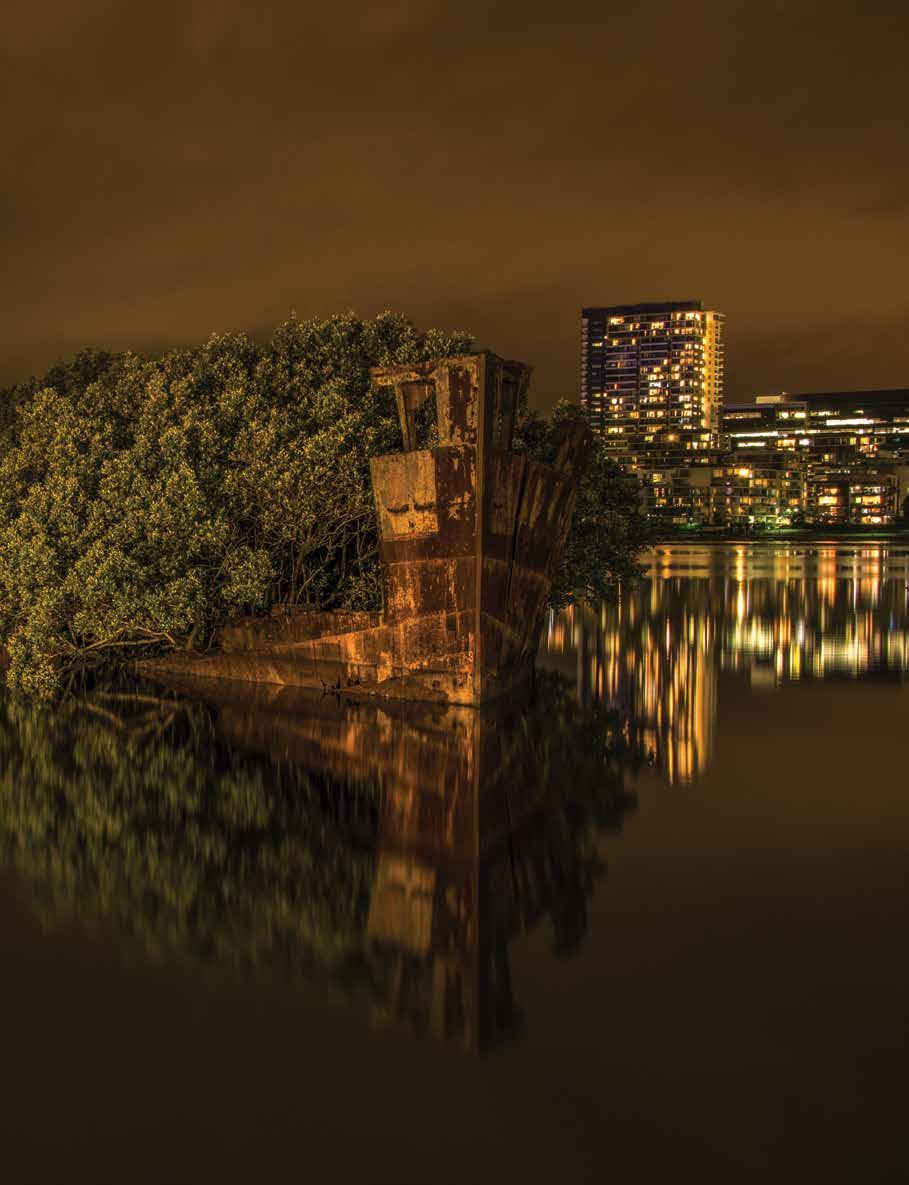
It’s a dark, shadowy world in Sydney’s swimming enclosures and beneath the city’s jetties

SYDNEY’S SUN-SPANGLED WATERS are central to the city’s national and international reputation. But just how much life lies submerged, hidden away from the above-water pressures of Australia’s biggest city and its ever-sprawling human population, beneath our most iconic landmarks, beaches and headlands?
Geologically, Sydney Harbour is a river valley that was drowned as the sea level rose about 11,000 years ago at the onset of the present interglacial period. But from a marine ecology perspective, it’s one of the world’s most modified estuarine systems. Along with Port Hacking and Botany Bay to the south and Pittwater and the Hawkesbury River to the north, the harbour is one of a series of deep waterways in the Sydney Basin that all drain along a shallow coastal strip between Palm Beach and Cronulla.
Interconnected rocky reefs along this stretch of coast are separated by swathes of mobile sediment that have adapted to withstand large and powerful waves. In the shallows, these reefs are covered in forests of seaweed that shelter common sea dragons feeding on swarms of tiny mysid shrimp. Also living here are giant cuttlefish, which have pigment organs called chromatophores in their skin that change in an instant, both in colour and texture, to transform these behaviourally complex creatures from flamboyant billboards to masters of disguise. Down in deeper waters, the reefs are covered in a living veneer of colour created by gardens of sponges, ascidians and tunicates in all shapes and sizes.
Blue gropers are a recurring and much-loved element of Sydney’s coastal life, famed for their tame behaviour, large size (up to 40 kilograms), blubbery lips and peg-like teeth. Just one or two dominant males usually occur within an area, along with a larger number of females. When a male dies or moves away, the largest female changes sex to become a replacement male. Many of Sydney’s resident gropers – such as ‘Bluey’ off Clovelly Beach – have been affectionately named by adoring locals.
Seven aquatic reserves protect some of Sydney’s most accessible and biologically diverse coastal areas. Cabbage Tree Bay Aquatic Reserve at Manly is one of the most popular, where snorkellers can experience southern eagle rays, dusky whaler sharks and crimson banded wrasse, often swimming around the occasional discarded junk such as an old motorbike.
Within Sydney Harbour’s estuarine environments, waters are generally shallower, more sheltered and prone to the influence of tide and salinity. Here, softer sediments provide the perfect habitat for bizarre molluscs, polychaete worms, echinoderms and crustaceans. Three aquatic reserves also afford protection for some of Sydney Harbour’s estuarine habitat in Towra Point in Botany Bay and Shiprock in Pittwater.
Stands of marine vegetation – including mangroves, seagrass and saltmarsh – provide isolated oases for wading birds such as stilts and pelicans, and habitat for juvenile fish and marine invertebrates. Seven species of seagrass are known from Sydney Harbour, with most found at shallow depths in outer harbour areas. Knowing that mangroves have been a declining habitat worldwide, it’s reassuring to find that the total mangrove cover in Sydney Harbour has increased since European settlement.
Operation Crayweed’s Adriana Verges measures the growth of transplanted crayweed off Bondi Beach, an initiative working to restore this species along Sydney’s coastline.
02
The charismatic eastern blue groper is only found off south-east Australia, and is regularly encountered off Sydney’s rocky reefs.
Seven aquatic reserves protect some of Sydney’s most accessible and biologically diverse coastal areas

The harbour is one of a series of deep waterways in the Sydney Basin that all drain along a shallow coastal strip between Palm Beach and Cronulla

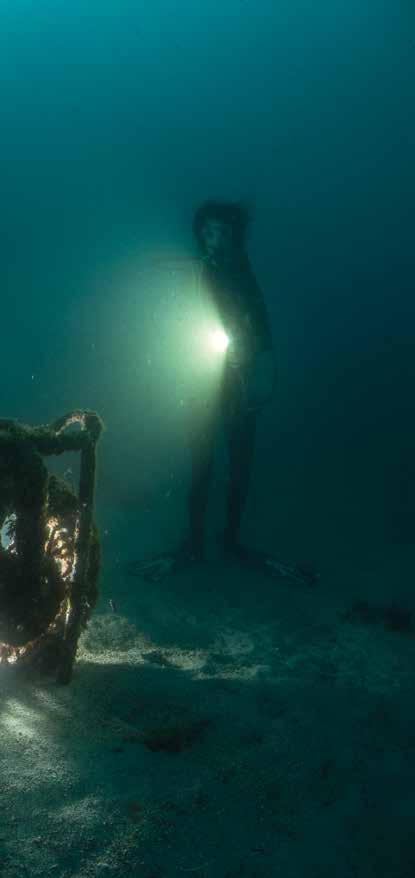
In contrast, however, the extent of saltmarsh has declined dramatically due to foreshore development, with only an estimated 37 hectares remaining.
These days the installation of marine infrastructure requires consideration of the marine environment through the planning and approval process. Developments over marine vegetation, for example, are heavily regulated, with significant penalties for unauthorised harm to plant species.
It’s a dark, shadowy world in Sydney’s swimming enclosures and beneath the city’s jetties. Differences in shade, orientation and water flow are strong drivers of marine plant and animal life around these artificial habitats. Such places have proved beneficial for species such as seahorses, which thrive on swimming enclosure netting as it provides increased food availability and refuge from predation.
Deeper in Sydney Harbour, the waters around Clifton Gardens are home to striate anglerfish. Perfectly adapted to the area’s soft sediment and low-lying sponge habitat, this species has exquisite camouflage and uses its fins like feet to walk along the seafloor. It also has a built-in lure for attracting prey and a large mouth to eat it. Common Sydney octopuses also occur here, their distinctive white pupils and orange-rust-coloured arms emerging from lairs under rock ledges.
Sydney’s marine environment is exposed to most of the threats faced by coastal cities globally, including habitat loss, foreshore development, pollution, stormwater run-off and introduced pests. But some plant and animal inhabitants appear to not only be coping with the shortcomings, but are also finding their own strongholds.
The harbour, for example, is extensively modified, with more than half of the shoreline replaced by artificial structures such as seawalls, jetties and piers. Researchers are now starting to deploy prototype structures in Sydney Harbour to better connect the built environment with the natural environment. An example is designing seawalls with niches and crevices to increase colonisation by marine species such as seaweed, barnacles, limpets and crabs. The design of these environmentally friendly seawalls makes them more like natural rocky intertidal areas, with increased habitat complexity and a gradually sloping face to dissipate wave reflection.
Sydney’s estuarine habitats have historically been polluted by industry, particularly shipping, resulting in a legacy of residual toxins trapped in sediment, notably in low-energy sheltered bays with limited tidal turnover. Some impacts have been so severe they still need to be managed today, such as a fishing enclosure cordoned off in Homebush Bay to prevent people from catching and consuming fish from that area.
There are a number of shipwrecks still visible in Homebush Bay, including the wrecks of colliers Ayrfield and Mortlake Bank, the tug Heroic, the steel boom defence vessel HMAS Karangi and several barges, dredges and lighters. These wrecks are the remnants of Homebush Bay’s former use as a shipbreaking yard, and have become overgrown by thriving mangrove thickets. The wrecks can be viewed from the shore from Bennelong Parkway at Homebush Bay and Bicentennial Park.

01
A veterinary surgeon at the Taronga Wildlife Hospital & Pest Control holds up a pied cormorant following surgery to remove ingested fishing hooks, visible in the x-ray.
02
Harriet Spark from Operation Straw inspires volunteers through organised beach clean-up events around Manly.

Sydney’s marine environment is exposed to most of the threats faced by coastal cities globally, including habitat loss, foreshore development, pollution, stormwater run-off and introduced pests
The quality of Sydney’s waterways improved significantly in the early 1990s with the relocation of coastal sewage outfalls to deeper offshore water. But it didn’t come soon enough for some species. Researchers blame poorly treated sewage and stormwater for the disappearance of a brown seaweed, known as crayweed, from Sydney’s coastline. The species occurs in shallow water, grows to a height of 2.5 metres and forms dense beds of spindly lime-and-yellow-coloured fronds. Historic photographs, herbarium records and early research observations suggest the species formed underwater forests between Palm Beach and Cronulla during the 1960s and ’70s.
Since 2011, a collaboration of researchers, students and community dive groups, known as ‘Operation Crayweed’, has been working to restore this remarkable underwater habitat to Sydney’s coastal waters. As a first step, Operation Crayweed began investigating the species’ importance as an ecological community. In areas of New South Wales further south, the team documented that up to 10 times more abalone was associated with crayweed, compared with other species of seaweed, and that crayweed also supports a unique community of invertebrates, whose absence is likely to have flow-on effects to other species in the ecosystem. The team’s findings were supported by evidence from Victoria that greater numbers of rock lobster are associated with crayweed than with other seaweeds. Recognising the importance of this marine plant, the team is now working to restore it along Sydney’s coastline.
It’s a testament to the health of Sydney’s waterways that they are home to the last mainland colony of little penguins in New South Wales. Its existence, in Sydney’s North Harbour near Manly, was kept a local secret for decades during the 20th century. As many as 70 penguin pairs arrive here between May and February to breed. It is one of more than 10 sites in the state where the species breeds, along with Lion Island in Pittwater.
Yet, according to staff of the Taronga Wildlife Hospital and Pest Control, debris has been identified as a major threat to the marine wildlife that end up in the hospital’s care, which includes penguins. They also regularly receive marine turtles that have swallowed plastics and shorebirds that have swallowed fishing hooks or have them embedded in their body or wings.
The team has documented plastics inside the intestines of turtles, such as plastic shopping bags – both single-use and biodegradable bags – and small plastics such as lids, ring-pulls and bait bags, as well as balloons and balloon string. These days, there are more plastics in the harbour, and with more humans come greater amounts of marine debris.
If the marine turtles that come to the wildlife hospital can be rehabilitated to the point of release, they are fitted with a satellite tag to monitor their survival and movement. Specifically, this technology is used to collect information on their migratory paths and determine habitat usage. Marine turtles are considered indicators of marine debris pollution and can be monitored fairly easily. Therefore, the team is working to identify vital feeding grounds and resting areas for these threatened species – information that can later be used to protect important habitats.
Marine turtles don’t return to their nesting beaches in tropical waters until they are more than 30 years old. The hospital’s tagging work has shown where and how these young turtles around Sydney spend their time before reaching maturity. Surprisingly, the turtles head into Pittwater and up the Hawkesbury River, which researchers now know are important feeding and resting areas for these animals.
Community groups around Sydney have recognised the significance of the marine debris issue and have passionately taken action into their own hands. ‘Operation Straw’ is one such volunteer-based citizen science project that collects plastic straws from Manly Cove, a popular dive site and hotspot for marine debris. The initiative was born when Harriet Spark began noticing discarded straws and plastics building up at her local dive site. Harriet finds that straws are the perfect starting point to convey the importance of reducing single-use plastics. She believes we can live without straws and other single-use plastics, and she has a strong belief in a future healthy marine environment for Sydney’s waterways.
In Harriet’s own backyard, the Cabbage Tree Bay Aquatic Reserve shows what can be achieved through protection and community support. Although there are many other places around Sydney that have marine debris issues, we can all play our part by making informed decisions as consumers. As a community we can do more to protect these beautiful areas by ensuring that we respect our often-overlooked underwater neighbours.
Justin Gilligan is a freelance photojournalist with an honours degree in marine science. He has worked on numerous projects with Australia’s Commonwealth and State Fisheries Agencies. Several of Justin’s images have also received international acclaim in prestigious international photography competitions; he is a finalist in Wildlife Photographer of the Year 55. For further information, see justingilligan.com.

During the museum’s temporary closure to the public, much has still been going on behind the scenes, including planning for an innovative international exhibition about migration.
WE HOPE THAT YOU ARE ALL STAYING SAFE AND WELL.
While the museum has been closed to the public, we have been taking this opportunity to phone our Members and reconnect with them. What we have learned is that you all love Signals, so we hope you enjoy this latest issue of your magazine.
A new project is afoot
As the end of the financial year approaches, we are excited to launch our tax-time appeal to support the museum’s Migration Heritage Fund.
Australia has one of the most culturally diverse populations in the world and our multicultural society is a vital part of our collective Australian identity. Since 1945, nearly eight million migrants have stepped ashore to infuse modern Australia with more than 200 different cultural and linguistic traditions.
One exciting new project is A Mile in My Shoes. In collaboration with the Empathy Museum (UK), it involves a mobile giant ‘shoe shop’ that houses a diverse collection of shoes and audio stories exploring our shared humanity. Visitors are invited to walk in someone else’s shoes – literally. Visitors borrow a pair of shoes and walk a mile in them while listening to an audio recording of their owner’s life story – and so being taken on both an empathetic and a physical journey.
A Mile in My Shoes has already proved popular in 30 locations throughout the world. One visitor named Cecile noted:
Such a great idea and so effective to steep your mind in someone else’s reality. The sound is so good, it’s as though the person is talking into your ear, confiding … I listened to a story of loss and resilience told in Victoria’s clear and poised voice – heartbreaking and inspiring. Many thanks for this one-off experience.
The Australian National Maritime Museum is a great match for this project, being a hub for telling migration stories through our Welcome Wall (onsite and online), Passengers Gallery, rooftop projections, touring exhibitions such as On Their Own – Britain’s Child Migrants and upcoming free exhibitions Faces of Australia and Migrant Belongings
We are also more than a museum – we create encounters and experiences that change people’s understanding of Australia. The museum is responsible for collecting and exhibiting the national migration story, to build social inclusion and community harmony and help combat racism, which is why projects such as A Mile in My Shoes are so important.
To support A Mile in My Shoes through the Migration Heritage Fund, please complete and return the slip included in this edition of Signals or go to sea.museum/migration-fund
Direct deposits to the museum can be made to BSB 062 000
Account number 1616 9309
For more details please contact Marisa Chilcott, Foundation Manager, at marisa.chilcott@sea.museum or phone 02 9298 3619. Marisa Chilcott Foundation Manager
Our calls to Members have also prompted some wonderful stories, two of which we would like to share with you.
Susan Tomkins has been a member since January 1992: I first thought of joining the Maritime Museum because I loved sailing and had always had an interest in early voyages to Australia.
I then thought there might be a business opportunity as well. I owned an antiquarian bookshop in Paddington in Sydney so approached the museum to find they were building up their collection of books after opening in 1990. I had at that time a few diaries and journals of early migrant trips to Australia in the 1880s. And yes they were interested.
I also dealt in maps and engravings, particularly specialising in Papua New Guinea and the Pacific Islands as well as Australia, so this also helped to build up their collection.
Over the years I have visited the museum many times. I particularly like the section on migrant stories – some of them so poignant and sad, others full of hope for a new life in Australia. The special exhibitions are also always fascinating, so I can’t wait for the museum to open again.
We wish to thank our generous donors who have supported the restoration of the Orontes model. This painstaking work continues, and we look forward to welcoming all supporting donors to the museum to observe the model’s progress and see first-hand how their donations have been used.

Keith Owen has been a member since 2002:
I was first acquainted with the museum when based in Sydney as State Director of the then Immigration Department in the early 1990s. I met Kevin Fewster (then Director), who was very keen to link the migration story to the activities of the museum. I used to hold a number of official functions at the museum – such a wonderful venue. One gathering was to promote citizenship. The guest speaker was Kay Cottee, then the Chair of the museum. She spoke about what it meant to her being an Australian when she sailed up Sydney Harbour at the end of her circumnavigation on her yacht Blackmores First Lady Well, there wasn’t a dry eye in the audience (including me!)
I retired from the Department in late 1990 and Kevin invited me to be a consultant to the museum to establish the Welcome Wall. The story went like this. The museum had to build a boundary wall due to the construction of a ferry wharf to service the casino nearby. He saw it as a great opportunity to showcase the museum to the passing traffic, otherwise it ran the risk of being just another wall covered in graffiti. He had visited Ellis Island near New York, where migrants to the USA were processed. There he saw a memorial with migrant names inscribed. Why not turn the museum’s boundary fence into a celebration of Australian migration?
But there was a difference. The names on Ellis Island were inscribed in alphabetical order. This meant that when you got to Z you couldn’t go back and insert more names. We decided to list names as received and let the Welcome Wall grow. We also thought that the random nature of the listing of the names would portray the richness of multicultural Australia.
My wife and I are now in Townsville, having lived for 20 years aboard our yacht. But each year, we visit Sydney and the Maritime Museum, which is high on our to-do list. We walk along the boardwalk and I see the Tu-Do and I recall receiving such refugee boats in Darwin. Then on to the Welcome Wall. It continues to grow and I feel very proud to have been part of the project.
We thank Susan and Keith for sharing their stories with us. If you have any stories you would like to share, please send them to me at oliver.isaacs@sea.museum
Oliver Isaacs Manager, Members Museum member Susan Tomkins. Image courtesy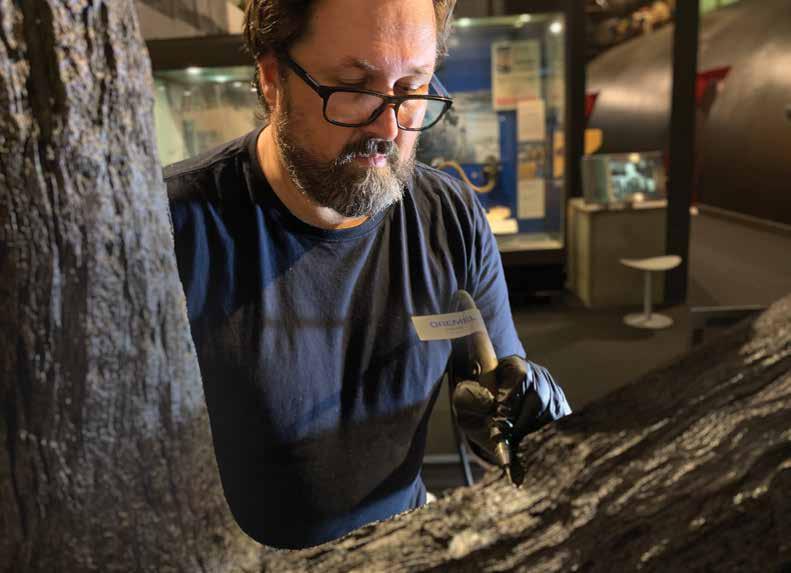
The Australian National Maritime Museum Foundation
COVID-19 has triggered dramatic changes in the operations of the Australian National Maritime Museum and many longstanding plans have had to be adjusted or shelved.
With the loss of up to $10M in self-generated revenue, roughly a third of our budget, the museum is looking to the Australian National Maritime Museum Foundation – and its donors – for extra help next financial year.
A recent study found that most museum-goers are unaware that museums are facing challenges due to COVID-19.1 Yet, when asked how they felt the loss of museums would affect them, either through closures or dramatically reduced services, most said they would be devastated:
Our museums help keep our collective memory alive. If we lost even one of these important institutions, it would be like someone had blown out a candle or turned out the lights on a vital piece of our society.
A huge blow to children’s education. These trips help spark curiosity.
Without these organisations telling the stories of marginalised communities, many of those stories won’t be widely shared at all.
The Foundation is requesting donations to:
• Acquire important objects for the National Maritime Collection
• Support a major new exhibition
• Support the conservation of precious objects
• Assist the museum with strategic projects such as the search for Cook’s Endeavour
Your tax-deductible donation will help with the museum’s recovery from COVID-19.
We are not alone and we know many other organisations are facing similar shortfalls and we greatly appreciate your support at this time.
For more information go to sea.museum/donate or contact
Foundation Manager Marisa Chilcott on 02 9298 3619 or email marisa.chilcott@sea.museum

Sailors plying Tasmania’s Derwent River or people on ships visiting Hobart might be surprised to hear that beneath their bows, installations of ceramic spawning habitat support a rare and charismatic fish. Jane Bamford and Dr Tim Lynch explain their roles in helping to save this endangered species.
Egg masses were observed over time and eggs successfully reached maturity in the field on the ceramic ASH
THE SPOTTED HANDFISH (Brachionichthys hirsutus) only exists in 12 sites in the Derwent River and surrounding coastal waterways. It was the first marine fish to be listed as critically endangered on the International Union for the Conservation of Nature’s Red List. Unlike many fish that spawn into the water column and let their progeny travel on the ocean currents as plankton, the spotted handfish spawns on habitats attached to the sea floor and, curiously, guards its egg mass for six to eight weeks until each egg hatches as a fully formed tiny fish.
The spotted and other handfish were first collected by François Péron in 1802 when he travelled to Tasmania on Nicolas Baudin’s scientific expedition. They obviously made quite an impression, as Baudin himself made note of this distinctive fish in his journal: ‘Amongst the fish, there is a little one which is rather unusual in that its foremost fins are exactly like hands, and that it uses them for clinging to rocks when it is out of water’. The River Derwent in the 1800s was a very different waterway from today. At the time of Baudin’s expedition, its pristine waters were traversed only by Aboriginal canoes. European settlement saw a massive increase in boat traffic, from the original convict ships, whalers and vessels plying their trade and transporting goods, to today’s cargo ships, cruise ships and yachts. This increase in boat traffic and the growing human population have had numerous effects on the health of the river – including a large (but now collapsed) scallop dredge fishery, heavy metal sediments, run-off, pollution and, as in all ports, the introduction of invasive species. In addition, anchorages have altered the condition of the seabed and affected the quality of the water. All of these factors have changed the spawning habitat of the once locally common spotted handfish, catapulting it into the category of critically endangered.
Currently the spotted handfish’s battle for survival relies partially on production and deployment of artificial spawning habitats (ASH), which replace the natural spawning habitat provided by stalked ascidians (Sycosoa pulchra). This beautiful marine invertebrate has also been almost wiped out locally as a result of grazing from the invasive northern Pacific seastar, which was introduced into the Derwent River in the late 1980s, probably through the discharged ballast waters of Japanese bulk carriers as they collected their cargo of woodchips. Since the late 1990s, the Commonwealth Scientific and Industrial Research Organisation (CSIRO) had been using artificial spawning habitats, initially small plastic sticks, to provide somewhere for the fish to spawn. While effective, these plastic ASH are a form of pollution and are easily displaced by fouling or being dug up by various animals on the seafloor.
In an effort to continue to support spawning, Dr Tim Lynch, senior research scientist at the CSIRO, and Jane Bamford, a Tasmanian ceramist, began to work together with the CSIRO’s spotted handfish team to design and produce a ceramic ASH option. This collaboration drew on a design process inherent to both science and art, as well as the expertise of other individuals from a wide range of backgrounds – technicians, scuba divers, PhD and Masters students, yachties, engineers and marine scientists – reflecting the team’s diversity of interests, as well as the colourful history of the Derwent River.
Consideration of scientific protocol determined that major features of the first design of ASH remained constant, while changing the material from plastic to ceramic. This enabled the CSIRO to test how the fish accepted the new material, while controlling for all other factors. Clay was chosen as a potential material due to its composition of natural materials, the stability of these materials in seawater and, once fired in a kiln to 1280°C, its latent biosecurity. Any ceramics that broke in the dynamic marine environment would result in something similar to an inert tumbled pebble over time, unlike plastics, which eventually break down into micro-plastic pollution that absorbs dangerous chemicals, which can enter the food chain in the river. Jane selected Southern Ice porcelain for its high durability and its white colour to match the hue of the stalked ascidian. It is a filter-pressed clay, which reduces the presence of mineral salts that might affect the ASH’s safety for the handfish to spawn on.
Since the late 1990s, the CSIRO had been using artificial spawning habitats, initially small plastic sticks, to provide somewhere for the spotted handfish to spawn


01 Each handfish has a unique pattern of stripes and spots, enabling individuals to be identified. Image Laura Smith
02
A wild adult handfish on a diver’s glove. Spotted handfish are small, growing to a maximum size of only 12 centimetres. Image CSIRO
Initially, Jane created ceramic ASH for the CSIRO tanks, intended for the captive breeding program in aquariums, which forms an insurance policy should numbers further decline. These ASH were designed and made with a stem – the potential spawning area for the female to attach her eggs – and, for stability, a small coil stand to be buried in the thin layer of sand present in the tanks.
The spotted handfish mating dance was witnessed in captivity for the first time in 2017. This gorgeous spectacle astonished the onlookers as a gravid female, with her fins extended like sails, circled the base of an ascidian, attaching and depositing her egg mass from her swollen belly. With heightened attentiveness she was tailed by a slightly smaller male, fertilising her abundant small clear egg sacs with his milt. The pair was known to the Hobart community as Harley and Rose.
In September 2017, a gravid female spawned around a ceramic ASH at Seahorse World in Beauty Point, northern Tasmania, in what is believed to be a world first. The eggs developed naturally, with spotted handfish young hatching and surviving at rates similar to those in natural habitats. This was very exciting, as it was the first sign that there could be success with ceramic ASH in wild populations, and that it might be possible to reverse the declining numbers of this critically endangered marine species.
The
spotted handfish mating dance was witnessed in captivity for the first time in 2017
In 2018, the CSIRO commissioned Jane to make 3,000 ceramic ASH for use in that season. The two components of ceramic ASH were designed and made to accommodate a shrinkage rate of 14–16 per cent when kiln-fired. Each upright was hand rolled to compress the clay and ensure it remained straight once fired. One end was gently tapered to fit neatly through the diameter of the hole in the disc, to assist with construction before each scuba deployment. The purpose of the disc was to add stability to the ASH in the river substrate. It was important to make the ASH easy to handle under water, as divers would work for long hours with thick gloves on in the late winter water temperatures off Hobart of 9 –11°C. A dedicated deployment system was devised by the CSIRO for divers to carry the ceramic ASH on the boats and assist in handling them under water while minimising breakage.
In June 2018, five sites were randomly selected and ASH planted along transects where the densest populations of spotted handfish had been observed in the past. Divers reported finding the ceramics easier to deploy than the plastics, as they are negatively buoyant. Astonishingly, the newly planted ASH had immediate interest from the spotted handfish, which was a very exciting and encouraging sign, and in September 2018 came the first report of egg masses on the ceramic ASH, brought by Alex Hormann, a University of Tasmania (UTAS) Masters student studying spotted handfish behaviour. Alex, Tim and CSIRO divers continued to dive on all the sites and collect data on spawning on both ceramic and plastic ASH, as well as on natural ascidian spawning habitat. Findings showed that the spotted handfish prefer to spawn on the natural ascidians, where present, but once ascidian numbers decline below a critical density they switch to the ceramic ASH. Most importantly, the fish preferred the ceramic to the plastic ASH that had been planted as controls, using the ceramics for breeding at nearly twice the rate of plastic. Egg masses were observed over time and eggs successfully reached maturity in the field on the ceramic ASH after the six-to-eight-week period that the female cared for them.
Astonishingly, the newly planted ceramic ASH had immediate interest from the spotted handfish, which was a very exciting and encouraging sign
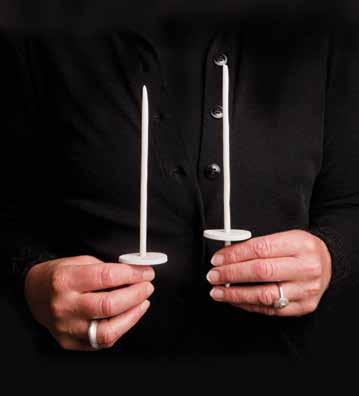
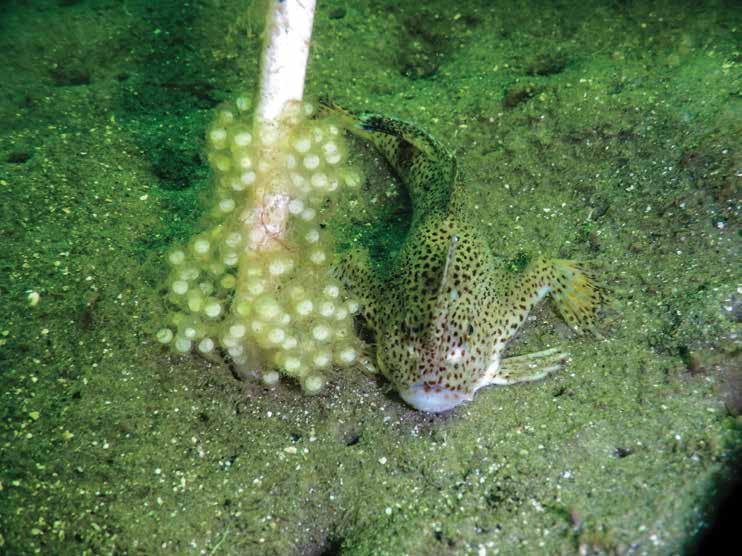
The ceramic ASH part of the project was recognised in late 2019 by winning the ‘Design for Impact’ category in the Design Tasmania Awards
Ceramic ASH had a higher rate of losses than the plastic ASH, probably due to large skates and rays landing on the ASH arrays and snapping them off at the base. To try to improve durability, the ASH stems were increased in diameter. In January 2019, five new diameters of ceramic stems were stress tested with the assistance of Dr Assad Taoum and his team at UTAS Engineering. On the advice of Dr Taoum, the disc component – an obvious weak point – was removed, and Jane made the ASH longer. No one knew if the spotted handfish would use the largerdiameter stems, and observation from divers in the field was critical to the decision. From this, two larger-diameter ASH, of 9 and 11 millimetres, were chosen to be hand made for the 2019 breeding season deployments to replace the original ASH stem size of 7 millimetres.
Our initial results from 2019 suggest that durability has increased dramatically, with losses down from 37 per cent to as little as 3 per cent, which is even better than the 8 per cent loss rate of the plastic ASH. The new design also allows for very easy cleaning. The longer ceramic ASH can be pulled out of sediments; the exposed top section is easily cleaned with dive gloves and the already clean, previously buried section then provides a clear, white surface for the next round of spawning. CSIRO divers counted stalked ascidians earlier in the year and then targeted ceramic ASH planting only where needed. With the much-improved durability and ease of cleaning, these new ceramic ASH arrays have the potential to last over the longer term. This has improved the viability of the conservation project by keeping down the cost of ASH production, deployment and maintenance. The ceramic ASH part of the project was recognised in late 2019 by winning the ‘Design for Impact’ category in the Design Tasmania Awards.
The Derwent River contains many small bays and safe anchorages, offering protection to yachts from the prevailing winds and locations where they can have permanent moorings. The spotted handfish also inhabit these bays, and unfortunately every time the wind changes direction, the heavy chain used to moor a vessel is dragged along the seabed, destroying the fish’s habitat. To conserve handfish habitat, Lincoln Wong, a PhD student at the University of Tasmania and the CSIRO, is working on trialling and implementing environmentally sustainable moorings with citizen scientist volunteers.
01 Jane Bamford with two of the original-design ceramic ASH. Image Uffe Schultz
02
The female spotted handfish guards her eggs for six to eight weeks, until they hatch as tiny, fully formed fish. Image Alex Hormann
These new moorings, designed by CSIRO engineers, replace the damaging heavy chain with a rubberised strop and dramatically reduce the impact of the mooring on the seafloor, with attendant benefits not only for the spotted handfish populations but for all biodiversity in these shallow waters. It is very exciting to think that this initiative, which can help conserve spotted handfish habitat, may also have a more widespread positive legacy in reducing the damage caused by moorings all around the world’s coastlines.
The impact of ceramic ASH design and production will further protect the spotted handfish from extinction, stabilise existing populations and allow for recovery.
More generally, it demonstrates a successful synergistic collaboration between art/design and science. The many similarities between these two fields – the development of practice, iteration, repetition, design, experimentation, craft, observation and measurement – have merged seamlessly. In many ways the work is also a performance by the divers, the artist and the spawning spotted handfish, which are an icon of the Derwent River. Using one of our most ancient technologies, ceramics, and creating a beautiful and tactile handmade small-scale production object, the project invites us to imagine this unseen underwater spawning performance. Furthermore, this encourages us to consider broader perspectives of the anthropogenic epoch and beyond. Is it possible for the River Derwent to return to somewhere near the condition in which the sailors and naturalists of Baudin’s expedition found it? As we consider how science, creativity and design processes can actively work in collaboration to avert the spotted handfish’s extinction, we might also contemplate how an innovative and collaborative approach might assist many species presently falling into the Earth’s sixth mass extinction.
The spotted handfish project has been truly a community undertaking, with some of the key supporting partners being National Handfish Recovery Team, UTAS Centre for the Creative Arts, UTAS Engineering, NRM South, Derwent Estuary Project, Sea Life Melbourne Aquarium, Marine Solutions, Reef Life Survey (Tas), Marine Biodiversity Hub, Department of Environment (Commonwealth), National Environmental Science Program, Department of Primary Industries, Parks, Water and Environment (Tas), Seahorse World, Clayworks Australia, Marine Life Tassie and Marine and Safety Tasmania. The project is part the larger handfish conservation project handfish.org.au/ For more information on Jane Bamford’s work, see @janebamford_ceramics on Instagram or visit janebamford.com
All
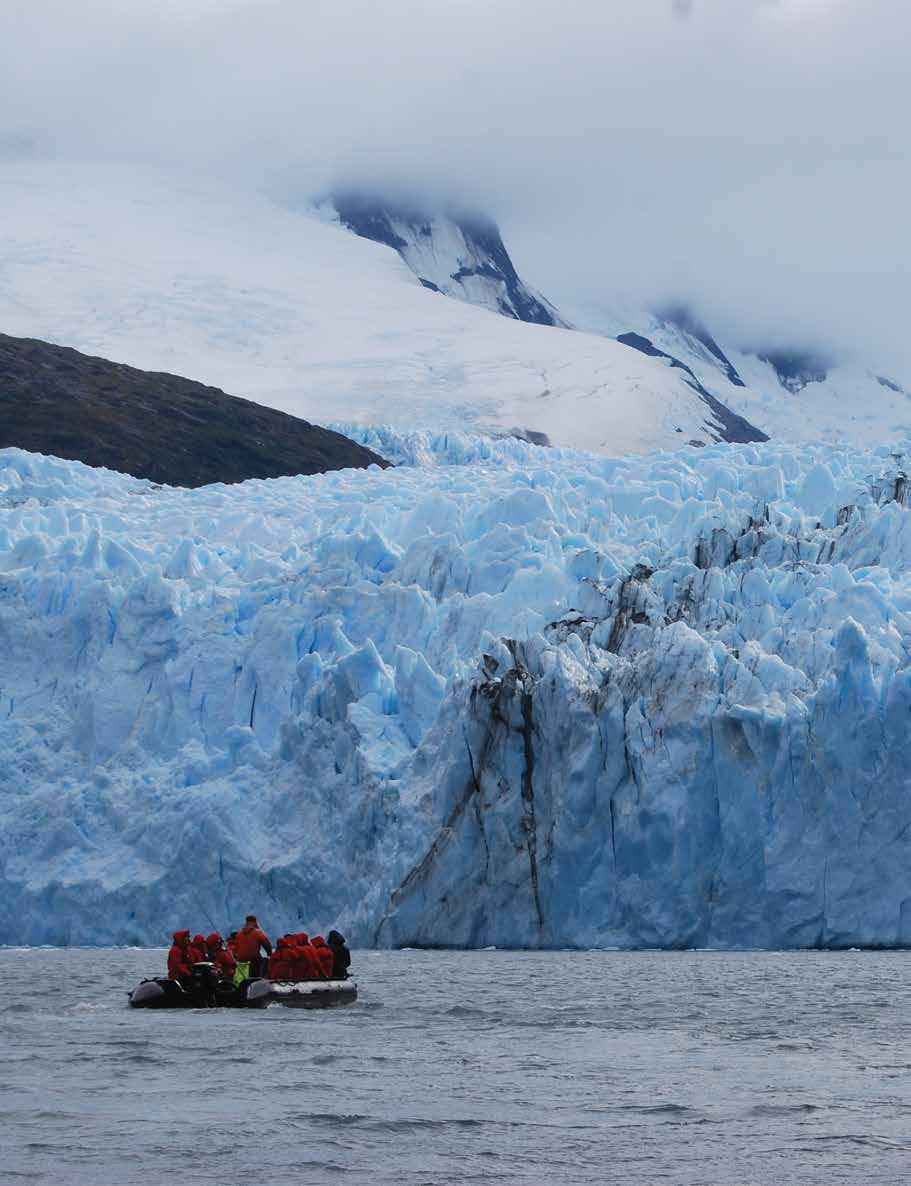 Cruise passengers in a Zodiac get a close look at the Garibaldi Glacier, Patagonia.
Cruise passengers in a Zodiac get a close look at the Garibaldi Glacier, Patagonia.
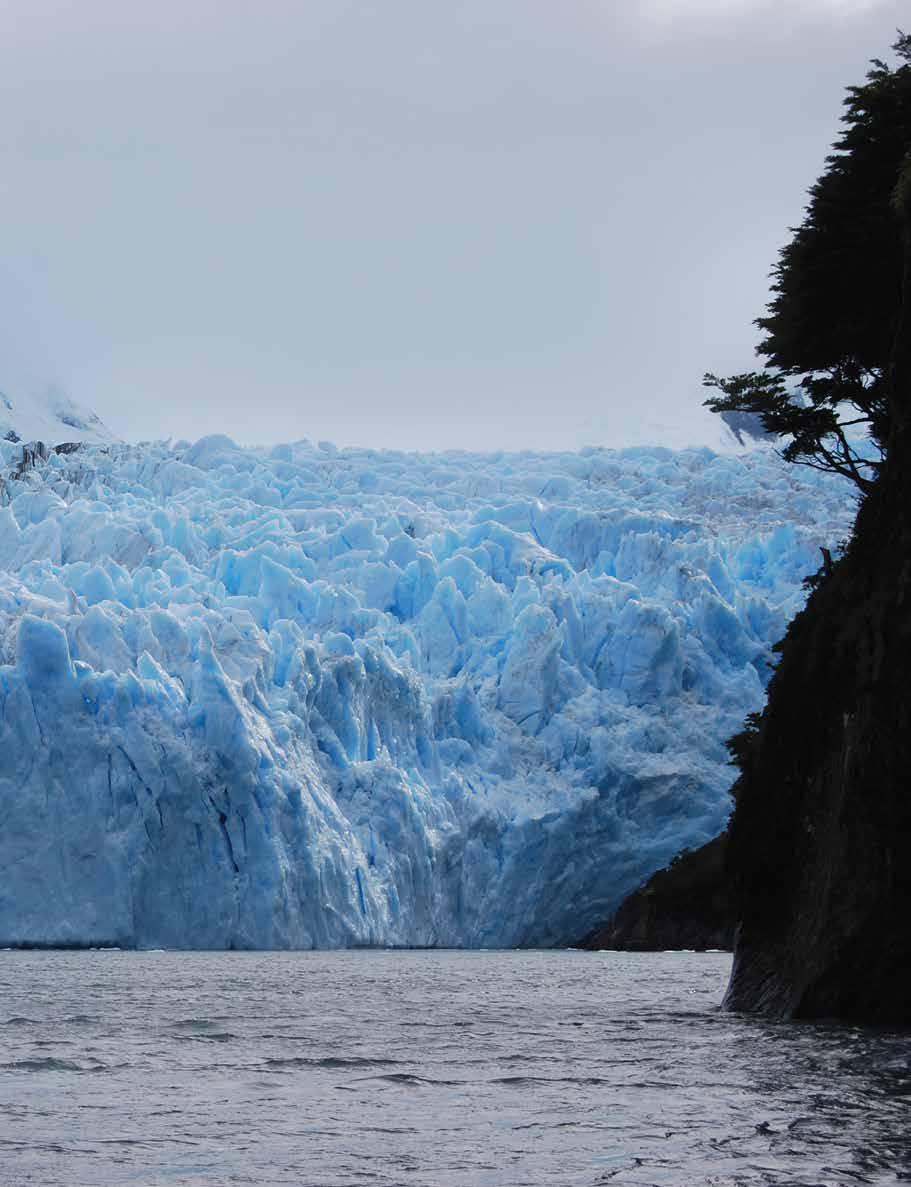
At 8.30 am on Wednesday 18 March, a LATAM 787 trundled down the regional airstrip at Puerto Montt in Chile at the start of what was probably the first trans-Pacific flight from this location. Although the plane’s capacity was more than 250, the only passengers were 16 Australians. The flight was the culmination of several days of boredom, frustration and high drama for most of the 150 or so passengers on the cruise ship Silver Explorer, as the COVID-19 pandemic began to bite in Chile. By Michael Waterhouse .
The cruise started uneventfully at Ushuaia, Argentina, on Wednesday 4 March, though against the background of growing global concern about the spread of the coronavirus COVID-19. All embarking passengers, including my wife Vashti and myself, had their temperature taken in Buenos Aires before flying to Ushuaia, with no one exhibiting any symptoms. Perhaps naively, we also took comfort from being at the other end of the world from China, the apparent epicentre of the virus.
The following few days were idyllic, the ship gliding gracefully back and forth through spectacular fjords, with Zodiac excursions to see glaciers and wildlife at close quarters. Nature at its most pristine.
The first township we encountered (Saturday 7 March) was Punta Arenas, its central tree-lined square dominated by a massive 19th-century statue of Ferdinand Magellan. This had been spray painted by demonstrators, and though cleaned, the residue was still evident. As the person who first opened up the area, Magellan is reviled by many as the man whose discoveries led eventually to the decimation of local indigenous tribes.
The museum, in a house once owned by a wealthy colonist (and so an oppressor of local tribes) had also been similarly defaced. Here and there on the walls of buildings, painted graffiti such as ‘Rebelion Popular!’ hinted at the potentially fragile nature of Chilean democracy.
We moved on up the coast of Patagonia, through more exhilarating fjords thick with ice floes, until we arrived at Puerto Natales (Monday 9 March) – the jumping-off point for Torres del Paine National Park. The scenery in the park was quite extraordinary and we’d been given enough geological information to make sense of it all.
Thursday 12 March: Next port of call was Tortel, a picturesque commune lining a fjord, with boardwalks winding irregularly around the waterfront. Back on board we were having lunch when the captain announced that a passenger who was suspected of having COVID-19 had been disembarked and flown to hospital.
Friday 13 March: A day at sea as we headed for Castro, with no idea of whether we would get ashore there – if the passenger tested positive, this would change everything. And so it proved. As we approached Castro on Saturday 14 March, news came that he had indeed tested positive and immediately after breakfast we were all asked to return to our cabins. This was day 1 of our confinement.

Fragments of emails which passed back and forth with our family in Australia convey a sense of how things played out.
Sunday 15 March (day 2): Vashti has a cold – blocked sinuses, runny nose and a slight headache. We thought it best to report this and did so this morning. However, although a Chilean medical team has been crawling all over the ship testing passengers, they haven’t been anywhere near us.
We haven’t been allowed out on deck for exercise and fresh air – we don’t have a balcony so no way of getting fresh air directly. Menus give us a limited choice from which to select breakfast, lunch and dinner. Food is of a high standard and you can request wine or beer. Its arrival is signified by a knock on the door and then you retrieve it once the masked crew member delivering it has gone.
Late this afternoon a flurry of activity, with the ship’s doctor ringing and a nurse visiting. Vashti’s temperature was up but within the ‘normal’ range. They’ve run out of swabs so will do this tomorrow morning.
Communication from the captain has been limited. We’re just sitting here, a few hundred metres out from shore (Castro, we think), with no idea of what’s happening.
(Later) As best I understand things, we’re officially in quarantine and can only leave when the Chilean government says so. Advice from the expedition leader Danny is that the US may deny us entry, and I guess this means others (Peru, Ecuador, Canada) may do likewise.
We see no-one, talk to few (by phone), watch films (good selection). As Vashti says, it’s amazing we’re still speaking to each other. Two days now without permission to step outside on deck, even when we’re right out at sea. We’re OK, really. Just frustrated at being confined to a 10 x 3.5 metre ‘prison’ (albeit one with excellent food) when people could easily be walking around the deck keeping a couple of metres apart. Apparently ‘protocols’ don’t permit this.
Cabin 323We see no-one, talk to few (by phone), watch films (good selection). As Vashti says, it’s amazing we’re still speaking to each other
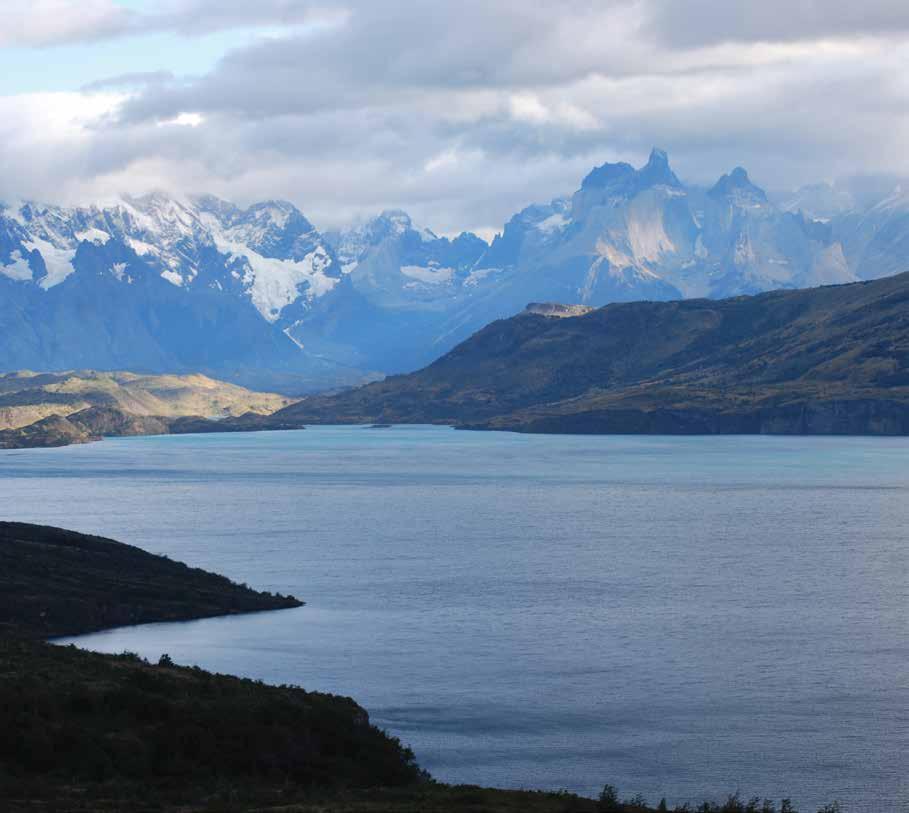
Four passengers and one crew had been disembarked in Castro as they had shown some coronavirus symptoms
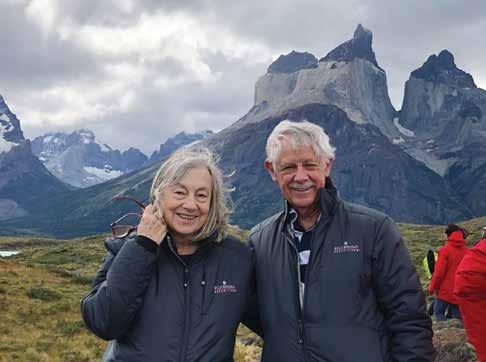
From our daughter (a doctor) in Sydney: The main thing to watch for is becoming breathless. As long as it is a blocked nose, cough, fever etc it’s probably staying in the upper respiratory tract (which is good) whereas breathlessness indicates it’s moved lower and this is more of an issue. If this happens, insist that they test you with a pulse oximeter (clip on finger that tells the oxygen in your blood).
Monday 16 March (day 3): Reception rang 10 minutes ago – at 4.10 am!!! – to say that Vashti had to be ready at 7 am for them to take her ashore in a Zodiac – probably a 10-minute ride – so she could be tested for coronavirus. Once I was fully awake and we’d had a chance to discuss it, I rang back and said this wasn’t going to happen, that Chilean officials had the whole day yesterday to check her but hadn’t, and that when a nurse checked her late in the day, her temperature and blood oxygen levels were within the normal range.
Initially, I understood that Vashti would just be going ashore for a swab, not realising that in fact she’d been asked to pack her suitcase. This was to be a permanent departure from the ship, though with no explanation given as to why it was necessary or where she’d be going. All we were being told was that she’d be going ashore. There was briefly a suggestion that I might accompany her on the helicopter, but they then equivocated as to whether there’d be room.
The risk of her being stuck in a regional hospital at Puerto Montt (near Castro) while the ship sailed away to God-only-knowswhere and then trying to sort out how to get back together again was just too great when there was no compelling medical reason for her to go. A little surprisingly, the Chilean health authorities didn’t press it. There was a flurry of increasingly impatient calls from reception and I was ready for guys with guns at the cabin door. If they were genuinely concerned, I’ve no doubt they would have forced the issue.
Vashti, in an email to our children in Australia: Didn’t appreciate being woken at 4 am and told to be packed and ready to go ashore at 7. But Michael took on the hotel lobby manager and the ship’s doctor and said he didn’t care what the Minister of Health said, I wasn’t going ashore. He even locked the cabin door but I daresay they would have beaten it down if they’d thought me really contagious. Those being disembarked were to be sent off in a helicopter and as M said, sitting with possibly contagious people in this would be risky.
(Later) At about 8.30 am the captain advised us that we would be moving off out to sea, though to an unknown destination. He said four passengers and one crew had been disembarked in Castro as they had shown some coronavirus symptoms.
We then sailed round and round in circles and are now headed back into Castro again. A few passengers, including ourselves, were given a chance to go up on deck, but asked not to tell others. Suitably rugged up, masked and gloved, and escorted by a crew member, we got 15 minutes to walk around the ship. It was terrific!
What happens when we get back to Castro is anyone’s guess, though I’ve just noticed we’re going out to sea again so it’s obviously not going to be for a while yet. I think cruise ships everywhere are being turned away and so we may end up like the Flying Dutchman, travelling round the world in perpetuity! Have just been asked for our requirements for medicines for the next 14 days. Not a good sign. I think it’s going to be a while before we get home!
Advice from Sydney: Silver Explorer is anchored off Puerto Montt. The locals do not want it to dock and let anyone off. Chile will agree to the ship docking only if countries with nationals on board each agree to repatriate their citizens –which means they have to arrange charter flights all the way home, not just accept you if you make your own way there.
01 Vashti and Michael at Torres del Paine National Park.
Tuesday 17 March (day 4), about 9 am: Captain’s just advised us to pack our suitcases as we could be leaving the ship at short notice. He asked us not to put anything out on social media. Two cabins nearby have yellow square stickers on them –presumably someone inside in quarantine. Modern equivalent to a red cross on the door in the Middle Ages when someone inside had plague!
Vashti: Having been kept in the dark so long it was a eureka moment when the captain came on this morning and actually SAID something. Up till now he’s been telling us nothing.
(Mid-morning): It looks like we will disembark in the next couple of hours. One of the crew told me we’d be going to another country, not Santiago. I had the impression that it will be a charter flight directly to Australia from Puerto Montt. If correct, we’ll be on our way this evening and back home tomorrow.
We continue to move aimlessly back and forth, our movements being closely monitored by a Chilean patrol vessel. Are they worried we’ll make a dash for the shore? No further announcements. Suitcases packed.
Lunch and now dinner have come and gone. Quality of food has declined, but it’s amazing they’ve been able to give us what they have, and even a choice.
(Later) From our daughter: I am told your flight will depart Puerto Montt @ 9am Chile time and arrive in Sydney @ 7.15pm Sydney time.
(11 pm): Announcement that passengers will be disembarking by Zodiac, beginning immediately, with people to be called by cabin number. Those suspected of having coronavirus to remain behind, their partners free to stay or leave. No indication about where we are to go.
Vashti and I were called in about the sixth group, about 11.30 pm. Temperature check: Pass. Mandatory face masks and disposable gloves on. Down the steps onto the Zodiac flopping back and forth, the glare of lights accentuating the inky blackness enveloping the ship. It was quickly apparent we were heading for a large car/bus ferry about 400 metres distant.
Our Zodiac pulled up onto a ramp at the rear of the ferry, quite unstable in the choppy water. Narrowly avoided a wet landing as we clambered out as best we could, assisted by men and women in gowns and masks, with several policemen nearby watching. No masks but pistols clearly visible.
Once on the ferry, and after a mad scramble for some carry-on bags we nearly left on the Zodiac, we were quickly hustled onto onboard buses, with instructions to sit separately – one person per two seats. There were six buses with perhaps 120–130 people. When everyone was in a bus, the ferry set off on what were told would be a 50-minute journey – destination unknown. In fact, it was more than 1½ hours before we pulled into what appeared to be a dimly lit industrial port a bit after 2 am (Wednesday 18 March).
Here were more police standing around, guns clearly visible, watching as the buses disembarked. A cameraman was running around filming in the dim light. Police were also filming on their phones.
The last bus finally ashore, we set off in a convoy – escorted by police cars with flashing lights – on a 40-minute ride along what appeared to be a series of back roads with the occasional house but mostly bushes and long grass. We assumed we were heading for an airport but still no word on where we’d be flying.

If Chile hadn’t taken the hardline stance it appears to have done, perhaps we’d be among the many Australians who were stranded in South America or on cruise ships long after we returned
Eventually around 3 am an airport emerged through the gloom, dim lights shining through fog, a large plane standing silently nearby. It was extremely cold, perhaps three degrees, as we were hustled into a terminal that was still under construction, and sealed off by glass from the rest of the building.
Given the secretive and impersonal nature of the process thus far, it was nice that someone, realising how cold it would be inside the terminal, had put out a blanket on each seat and a pack containing drinks and nibbles. I assumed we had Silversea to thank for this, as the Chilean government’s haste to get rid of us didn’t suggest they were into nice gestures.
After a certain amount of confusion, it was eventually explained to us that there would be three flights – one to Miami for the Americans, one to Sao Paulo and thence to London for British and Europeans and one back to Sydney for the 16 Australians. However, our suitcases had been left on board – Silversea later explained to us that ‘the Chile government would not allow the luggage to be transferred to your flight home’.
The Americans left almost immediately. Eventually, at about 5 am, the British and Europeans and ourselves split into two groups and left the terminal in our respective buses. We sat in ours near a LATAM 787 for what seemed like another hour before the 16 of us were allowed on. Eventually we took off at 8.30 am, almost 24 hours after we were first told to get ready to disembark. The flight was about 14 hours, skirting Antarctica and arriving in Sydney at 11.40 am on Thursday. More temperature checks, through passport control, into a car provided by Silversea, and then home. Exhausted, but home and into isolation.
For the first few days we were both exhausted. Vashti described it as the worst jet lag ever. Our daughter prevailed upon us to be tested for COVID-19 and later that day we were advised we’d both tested positive.
About a week later I developed a cough and as it became more severe, I was admitted overnight to St Vincent’s Hospital for tests. An X-ray and CT scan revealed that I had bronchopneumonia. With the benefit of antibiotics it cleared gradually, with no lasting effects. This and the extreme tiredness were the worst of our experience with COVID-19. Given what others have been through and the deaths of a number of people of about our age, we can only consider ourselves extremely fortunate.
As we convalesce at home, we’ve reflected on how differently this could all have played out. In all likelihood, had Vashti been tested on the ship in Chile – and it was only because they ran out of swabs that she wasn’t – she would have been positive.
In retrospect, our decision for Vashti not to leave the ship proved critical. Had she simply gone along with their request, as she was inclined to do as she wasn’t feeling well, she’d still be in Chile, in a hospital somewhere or perhaps discharged into some other accommodation.
It was evident from everything we heard and which occurred while we were on Silver Explorer that the Chilean government was single-minded in its efforts to ensure that those on the cruise ship did not infect the local population (a view soon adopted by many other countries, including Australia) and that the issue be resolved as quickly and as quietly as possible. Perhaps the ‘Rebelion Popular!’ graffiti in Punta Arenas highlights why the government may have been particularly sensitive to the mood of its nationals.
After we returned, I assumed that the Australian government had paid for our flight. Not so. It transpires that Silversea paid LATAM what must have been a considerable amount to fly us back to Australia.
Ironically, if Chile hadn’t taken the hardline stance it appears to have done, perhaps we’d be among the many Australians who were stranded in South America or on cruise ships long after we returned.
So the stars aligned for both Vashti and me when the outcome could so easily have been far worse. Watching TV footage of others on cruise ships, confined to their cabins and retrieving food left outside their doors, remains a discomfiting leitmotif.
Michael Waterhouse is an economist and historian.
His book Not a Poor Man’s Field. The New Guinea Goldfields 1942 – An Australian Colonial History was published in 2010. Vashti Farrer is an award-winning author.
Have you been on a cruise ship recently? Tell us your story
Cruise liners form an integral part of the spread of the COVID-19 pandemic in Australia.
Were you a passenger, crew member or responder on any of the cruise ships caught up in the recent public health crisis?
The Australian National Maritime Museum would love to hear from you about this important moment in our national maritime history. Memories, photographs, artefacts and memorabilia will help us tell this story. Please contact curator@sea.museum with your email or phone number and we will get back to you.
For more details go to sea.museum/covid-stories
The museum’s teams have been busy developing innovative ways to continue sharing Australia’s stories of the sea
On 24 March, the museum temporarily closed its doors as a response to the COVID-19 global pandemic. It is now preparing to reopen and welcome visitors once more.
AS SIGNALS GOES TO PRINT, the museum plans to re-open its doors on 22 June to visitors in a limited capacity. We are working through the arrangements to ensure the safe operation for both patrons and staff. These will include increased cleaning, distancing procedures, online bookings, timed visits and allocated times for vulnerable sectors of the community.
We are greatly disappointed that, due to the social distancing measures, some events – such as the popular Classic and Wooden Boat Festival – could not go ahead this year.
Sadly, we were also unable to proceed with the voyage of the HMB Endeavour replica around Australia or the accompanying travelling exhibition Looking Back, Looking Forward, designed to mark the 250th anniversary of James Cook’s charting of the east coast of Australia.
However, the museum has developed a wide range of online content to commemorate this event, which you can read about on pages 47–48.
With Australians staying at home and bans on international visitors, the museum’s teams were busy developing innovative ways to continue sharing Australia’s stories of the sea. We’ve created a virtual museum at sea.museum/ so you can explore many of our exhibitions, collections, vessel tours and library resources online. We’ve also created new digital offerings, such as games, behind-the scenes videos, past editions of Signals and a virtual edition of our popular Ocean Talks series. You can read more about these online talks on page 44.
Work continues on site to ready the museum to again receive visitors. We are installing a new permanent exhibition, Under Southern Skies (see page 46), which can be seen in person once the museum reopens. Online exhibitions currently available are Elysium Arctic, Sea Monsters, War Brides, Wildlife Photographer of the Year, Undiscovered: Photographs by Michael Cook, Waves of Migration, Sea of Rainbow, On Their Own: Britain’s child migrants, and War and Peace in the Pacific 75 For more information on these online exhibitions, as well as onsite exhibitions planned for once the museum reopens, please see pages 46–48.
Our Education team has created new online programs to support teachers, parents and students. They include content to create a deeper understanding of Cook’s voyage as part of the Encounters 2020 program and digital case studies in the museum’s key themes of migration and maritime archaeology.
There are also engaging videos for children, such as the lighthearted Pirate School with the museum’s resident pirate captain Grognose Johnny, plus plenty of kids’ activity sheets featuring puzzles and colouring activities, which can be downloaded and printed at home.
Please stay connected with the museum by following our Facebook page and visiting our website for our virtual content. We look forward to welcoming more back visitors to our Darling Harbour site in the coming months.
Michele Camilleri, Strategic Communications Manager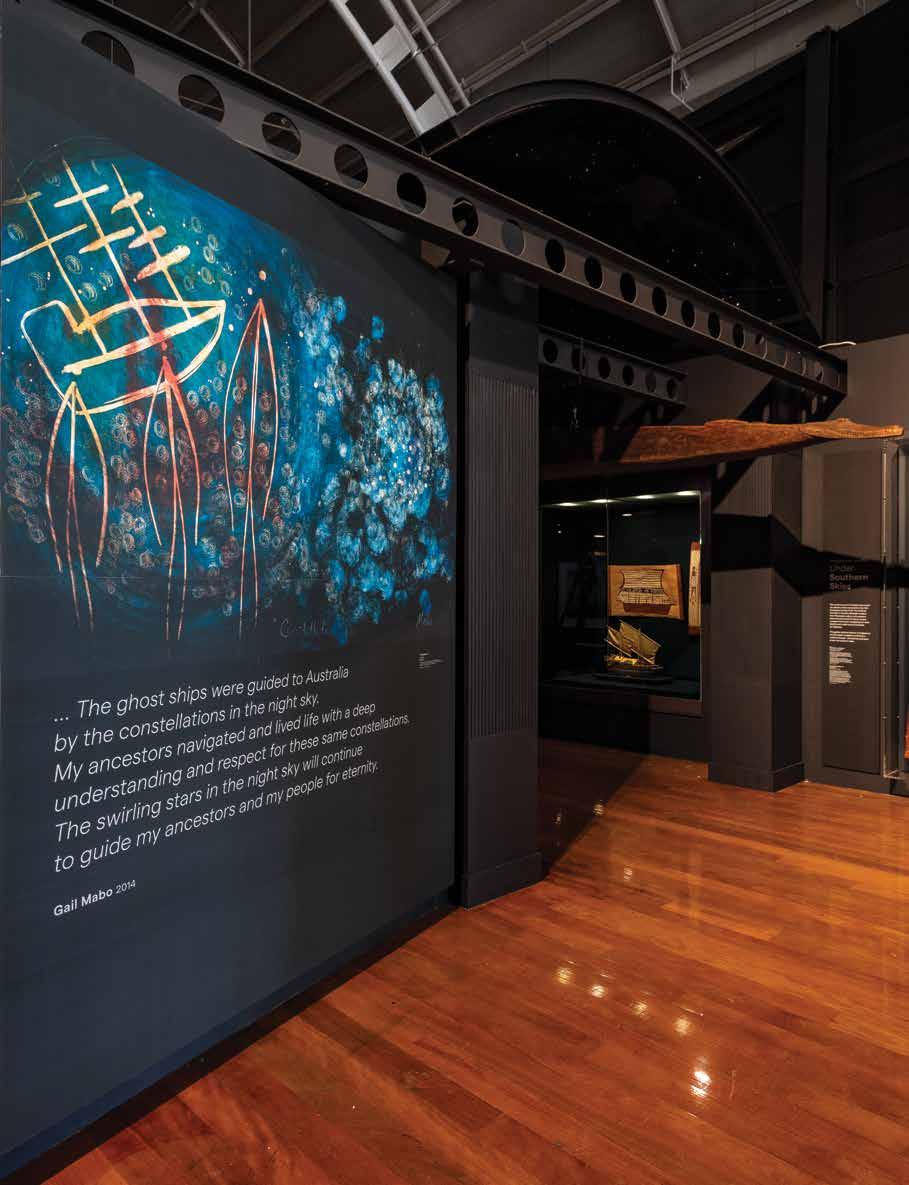
new permanent

For sailors, dancing on board ship had a long and established tradition and was a favourite entertainment
One perspective of James Cook that has rarely been examined is how music, theatre and dance were interwoven into his life and served to venerate him after death. He used music and dance to keep his crew healthy and to establish peaceful communications with people he encountered on his voyages, and his own life was commemorated in dance. By Dr Heather Blasdale Clarke .
Captain Cook wisely thought that dancing was of special use to sailors … it was to this practice that he mainly ascribed the sound health which his crew enjoyed 1
DURING THE 18TH CENTURY, the English were known as a nation of keen and accomplished dancers, from the king to the lowliest labourer. Indeed, it was one of the chief ways people entertained themselves. The English country dance was a highly social dance form; perhaps this accounts for its great popularity. Many new compositions were published each year to cater for the burgeoning demand, and their titles were inspired by current affairs of the world. Important events, famous people and significant places were all celebrated in music and dance. My research began with the discovery of The Transit of Venus in a collection of dances from 1775.2 This sparked an extensive study that traced Captain Cook’s life, achievements and death through the popular culture of the time.
and visiting women dance to a fiddler’s
deck
a ship. © National Maritime Museum, Greenwich, London, Caird Collection ID PAH7355
The enthusiasm for dancing in the Georgian era led to the building of so-called ‘assembly rooms’, constructed expressly for this purpose. It is fascinating to note that after his marriage, Cook chose a home for his young family next door to such a venue in Assembly Row, Mile End, east London – a place itself celebrated in the dance The Mile End Assembly. Assembly rooms were reserved for the upper and middle classes, while people lower down the social ladder danced in taverns. The English navigator William Dampier noted that his sailors learnt to dance in the ‘musick houses’ 3 in Wapping, the same dockside area in London where Cook’s in-laws kept the Bell Tavern.
For sailors, dancing on board ship had a long and established tradition and was a favourite entertainment. It was more than the drunken frolic that we in the 21st century might imagine; it was a skilful art requiring balance, co-ordination, strength and endurance. The best sailors were the topmen, who climbed high into the rigging and were regarded as the elite in the seamen’s hierarchy. They were also considered the best dancers.
Dancing was widely judged to have health-giving qualities, and Cook recognised these benefits and utilised them to good effect. According to the historian Carlo Blasis writing in 1830, Cook, ‘wishing to counteract disease on board his vessels as much as possible, took particular care, in calm weather, to make his sailors and marines dance to the sound of a violin, and it was to this practice that he mainly ascribed the sound health which his crew enjoyed during voyages of several years continuance.’ 4 Modern scientific research endorses dancing as one of the best forms of exercise, maintaining good physical, mental and emotional health, including as it does creative expression, co-ordination, musicality and social interaction.

On Cook’s voyages in the Pacific, the ability of sailors to dance added a positive and cheerful tone to encounters with Indigenous people. It was employed in cultural exchanges when Cook’s men danced hornpipes and country dances to entertain the islanders, in attempts to reciprocate their rituals of greeting. Music was provided by the ship’s musicians; on the Endeavour, the fiddler was Thomas Rossiter. On subsequent voyages the Admiralty arranged for a number of musicians to be part of the crew.
As Cook noted in August 1773 in Tahiti:5
When the king thought proper to depart, I carried him again to Oparree in my boat; where I entertained him and his people, with the bag-pipes (of which music they are very fond) and dancing by the seamen.
The president of the Royal Society, Lord Morton, issued ‘a list of hints’ to Cook and the gentlemen on the Endeavour. These hints include advice on how to approach the people they would meet – ‘not with the report of Guns, Drums, or even a trumpet ... but if there are other Instruments of Music on board they should be first entertained near the Shore with a soft Air’. The Admiralty supported this approach and on Cook’s second and third voyages organised a variety of instruments, including Highland bagpipes, French horns, hautboys (oboes), fifes and flutes. It was firmly believed music and dance helped to establish friendly contact, having the power to entertain, amuse and pacify: ‘I caused the Bagpipes and fife to be played and the Drum to be beat … this they admired most’, noted Cook in 1773 while in Dusky Bay, New Zealand.6
News of Cook’s travels and discoveries caused intense interest in Britain and throughout Europe. Before the era of film and television, it was difficult for people to visualise the places and people he had encountered. An important way to present the story of Cook’s voyages was through the theatre.
The first ballet to portray Cook was produced in Italy in 1784 and was titled Gl’inglesi in Othaiti (The English in Tahiti). It received dazzling reviews, was staged many times and was translated into German and Spanish.
The first English production was the pantomime Omai, or, A Trip Around The World. The title referred to the Tahitian man Omai, who had travelled to England with Cook in 1774 and achieved celebrity status before returning home two years later. The pantomime, staged in 1785 at the Covent Garden Theatre, London, was an immediate success – a blockbuster of the 18th century. The characters and scenery were drawn from the places Cook had visited, featuring authentic costumes, impressive stage designs and extraordinary special effects. The plot had little to do with Cook, but presented Omai as a Prince of Tahiti who fights the enchantress Oberea in order to regain his throne, before sailing for Britain to claim his bride ‘Londina’. A theatre critic from The Morning Chronicle wrote: 7
Every person who has read the history of Captain Cooke’s [sic] Adventures, should see the new pantomime Omai.
The manners of the natives in the new discovered islands being there pourtrayed [sic] to the life, and the soil, and culture of Otaheite, &c. picturesque beyond imagination, or what can be conveyed into the understanding by reading or plates.
01
Wapping by Thomas Rowlandson (1807) depicts a scene from a sailors’ tavern in London.
© National Maritime Museum, Greenwich, London ID PAF3823
02
Title page and dance instructions for Captain Cook’s country dance, published in London in 1797. Public domain
Assembly rooms were reserved for the upper and middle classes, while people lower down the social ladder danced in taverns
Following the great success of Omai, a new theatrical extravaganza was created, first in Paris, then in London: The Grand serious pantomimic ballet, The Death of Captain Cook 8 The story bore little resemblance to any actual event. It did, however, give an elaborate depiction of the people and places Cook had visited. The scene is set on ‘The Island of O-Why-e in the South Sea’ where the king of Hawaii is at war. Cook assists in defeating his enemies and although the ruler wishes to execute the prisoners, Cook saves them. Despite this he is attacked and murdered by the enemies, as they regard him as responsible for their defeat. The first performance evoked tears and hysterics when the audience saw the captain stabbed to death. This dramatic if fanciful representation of Cook’s death was an important factor in the ballet’s ongoing success and popularity throughout the British Isles, Europe and America. In the late 18th century it was common for plays, pantomimes and ballets to include dances that could be adapted for a social setting. The dance Omai was an example of this – it came directly from the pantomime and was published in Campbell’s 2nd Book of New and Favourite Country Dances (c1786). People across an increasingly industrialising Europe and North America were fascinated with Cook and with his travels in the exotic and remote Pacific region. We know of the numerous books and paintings created about the great navigator, but comparatively little about the number of dances created, such as Transit of Venus, South Seas, Island of Love, Trip to Ottahite (Tahiti), and Captain Cook’s Country Dance. It was in dance and song that people from all walks of life could venerate the great navigator.
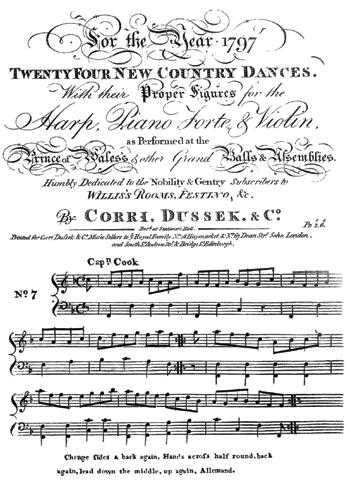
1 Blasis, C, The code of Terpsichore. 1830, London: E. Bull.
2 Bride, Favourite Collection Of Two Hundred Country Dances 1775, London.
3 Dampier, W, A New Voyage Round The World. 1697, Printed for James Knapton ... London.
4 Blasis, op cit.
5 Cook, J, The three voyages of Captain James Cook around the world. 1821.
6 Cook, J, J C Beaglehole and S Hakluyt, The Journals of Captain James Cook on his voyages of discovery. 2, 2. 1969, Cambridge: Published for the Hakluyt Society at the University Press.
7 The Morning Chronicle. 1785 London.
8 The death of Captain Cook a grand serious-pantomimic-ballet, in three parts . 1789, London: Printed for T Cadell, in the Strand.
Dr Heather Blasdale Clarke is a dance teacher and historian specialising in early Australian colonial culture. She has carried out extensive research in this hitherto untouched area of social history, including doctoral research into the intriguing topic of convict dance 1788–1840. She has developed a free online resource: colonialdance.com.au/dancing-with-cook. A book and CD, Captain Cook’s Country Dances, have recently been released, as well as a unit for teachers aligned to the primary school curriculum; they can be purchased at the above website.
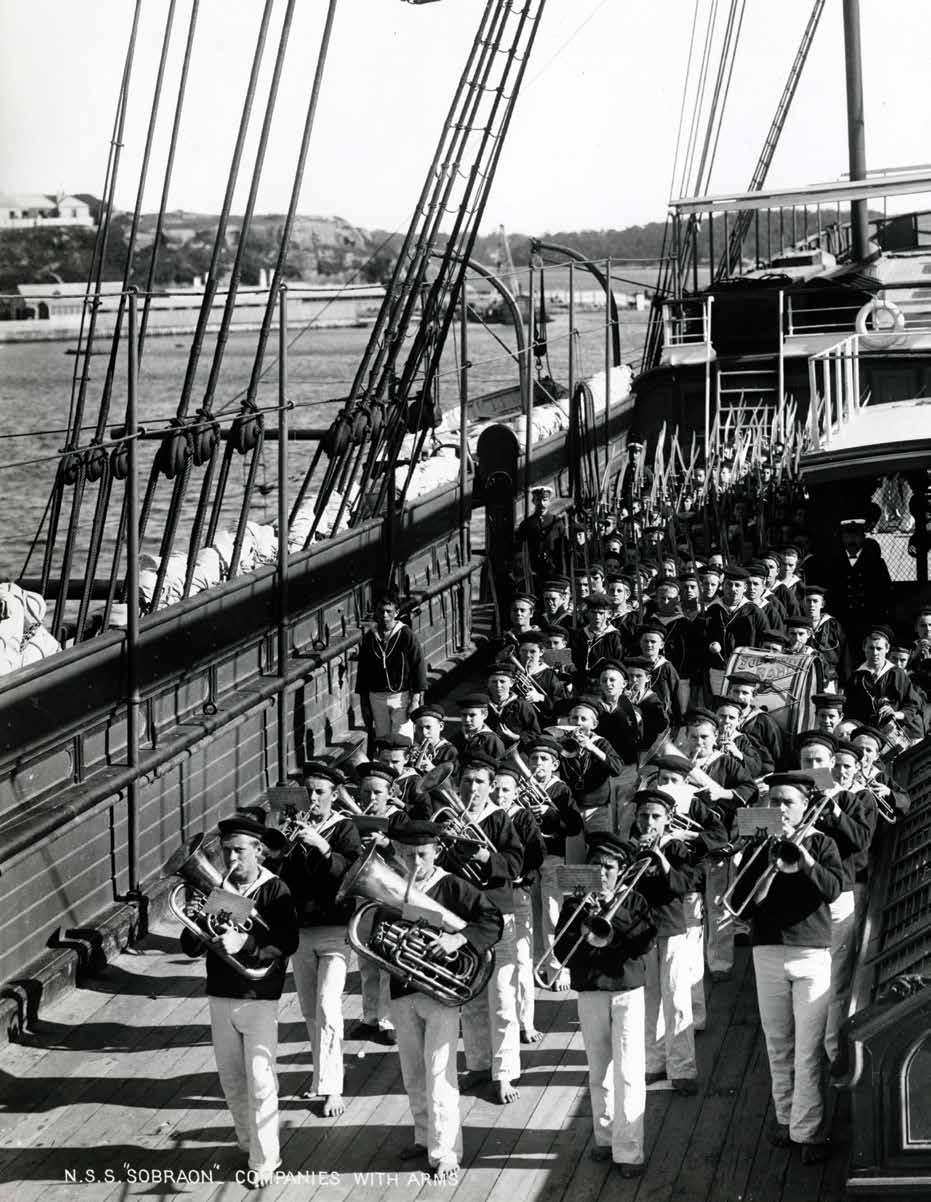 Boys performing drill aboard Sobraon ANMM Collection ANMS1096[205]
Boys performing drill aboard Sobraon ANMM Collection ANMS1096[205]
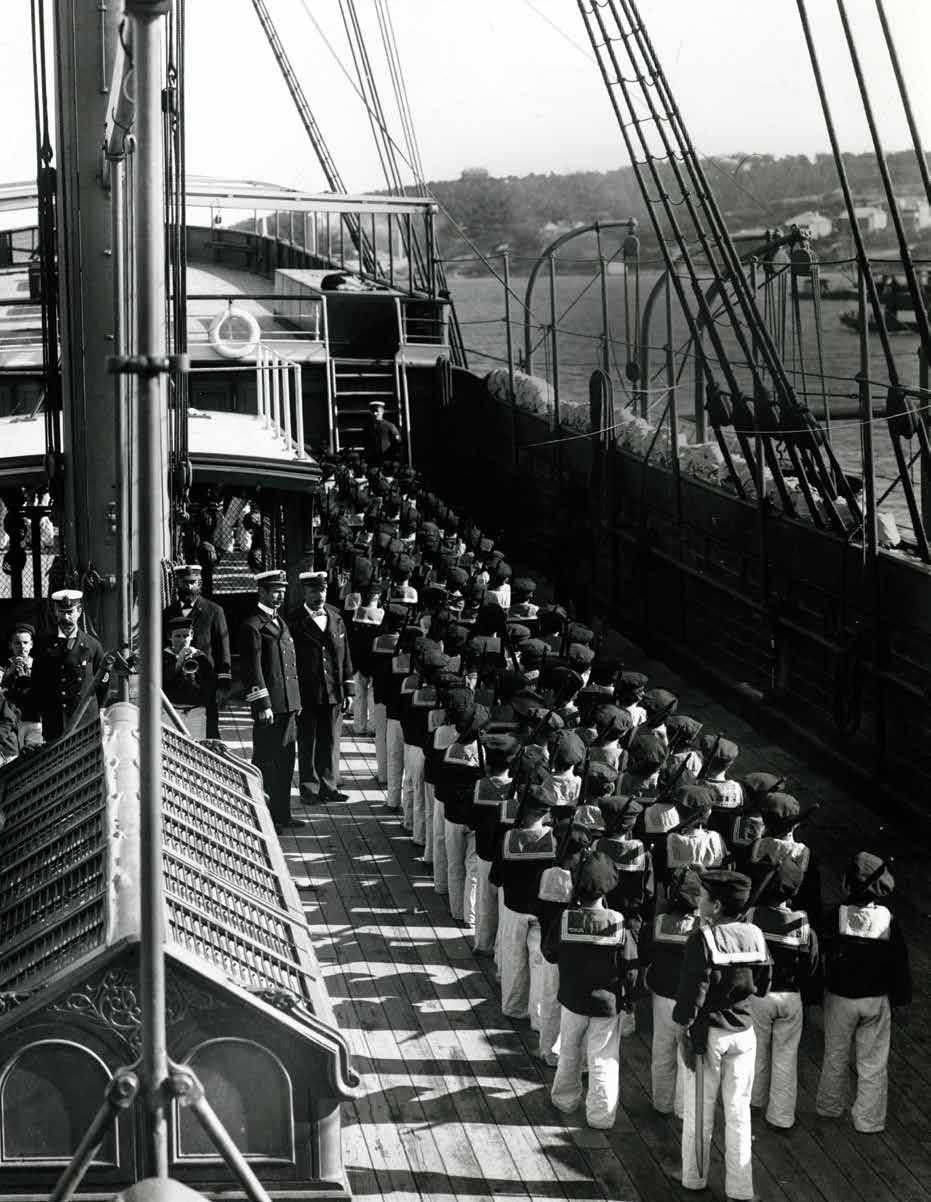
Delinquent boys, or ‘larrikins’, who were arrested and sent to Sydney’s Nautical School Ships Vernon and Sobraon between 1867 and 1911 were educated by an eccentric curriculum of academic lessons, trade-training and recreation, all designed to civilise them. Fascinating traces of these activities can be found today in items in the museum’s collection, writes Sarah Luke .
01 The manning of Vernon ’s yards –with the boys spidering up the masts in their neat sailor suits – was often the focus of photographic images of the era. ANMM Collection 00027245
02 Recreation on Cockatoo Island, with the Sobraon anchored nearby. ANMM Collection ANMS0031[100]
One journalist from the time mused that visiting the Vernon was on many tourists’ lists of must-do activities

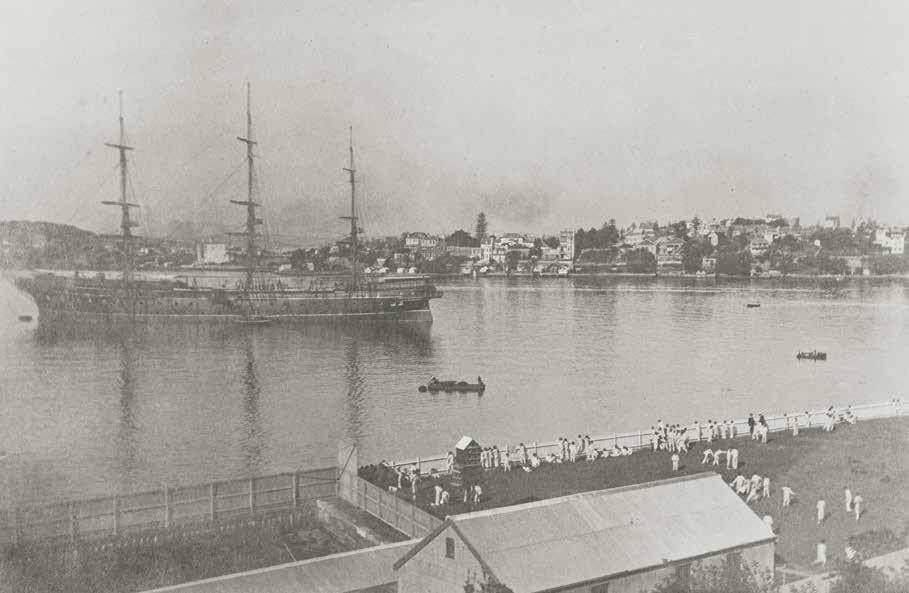
With the introduction of the Industrial Schools Act in 1866, being uncared for became a crime if you were a child or teenager
IN THE 1860S, SYDNEY’S WHARVES AND SLUMS were crawling with poor and neglected children. They spent their days shining the boots of the patrons of their parents’ ‘houses of ill fame’ (brothels), selling watercress and matches on the streets, and picking pockets. Some had homes – ramshackle houses devoid of furniture – and parents who were frequently drunk. Others were street orphans who were integral members of the city’s various gangs, or ‘pushes’. Some of these neglected youths might have had a little education – the well-meaning teachers at the Ragged Schools1 having managed to teach them the alphabet, at least – but most could not even write their own names.
In 1866 that all changed, with the introduction of the Industrial Schools Act . This legislation gave the police power to arrest children under 16 who had no job, who merely ‘wandered’ the streets, or who were being neglected by their parents. Being uncared for became a crime if you were a child or teenager.
To receive these boys, the state government purchased and fitted out a vessel, the Nautical School Ship Vernon, and anchored it permanently in Sydney Harbour. For some time the Vernon remained near Farm Cove (where the Sydney Opera House now stands), but by the early 1870s had found its permanent and famous home further west, beside Cockatoo Island. For the next few decades, Vernon ’s bugle-call frequently interrupted the working harbour as it signalled a change in the boys’ daily routine.
The floating institution quickly became an icon of the harbour. One journalist from the time mused that visiting the ship was on many tourists’ lists of must-do activities. 2 Bright purple tickets were issued to ladies and gentlemen keen to see the boys in the middle of their reformation from larrikins to useful, productive members of society. Visitors also revelled in dramatic militarystyle drill displays by the youthful cohort. Impressed visitors often sent treats to the ship – baskets of fruit, books and games.
Fresh sea air and strict naval-style discipline were what these boys were thought to need to catalyse their reformation. The Vernon had advantages in that escape was almost impossible should any boys desire to return to their old lives. It would require stealth to get into the water, and strength to survive the swim to shore – but the difficulty of escape also created in the public imagination the notion that the ship was akin to a juvenile prison hulk. This perception was – and still is today – difficult to shake off.
Naval-style discipline
Once brought on board, new recruits were installed into a strict routine. The boys’ days were divided between school, trade training – such as carpentry, sail-making, agriculture on Cockatoo Island, sailing and baking – and various types of recreation. After about a year on board, boys were then apprenticed somewhere in New South Wales until they were 18. On their 18th birthday they would be given the wages they had earned, with the intention that they could then look after themselves and find work in the trade in which they had been apprenticed.
It took some time for the ship’s order and routine to be established. The Vernon ’s early years were plagued by troubles: fighting between the staff – thanks to the inept first superintendent, Captain Mein – poor-quality food, and confusion about the purpose of the institution.
The first two teachers, in particular, were disastrous. The original one, Henry White, was arrested mid-lesson one day, charged with forgery. He consequently spent time in Darlinghurst Gaol, beside the parents of some of his former pupils. White’s replacement, John McSkimming, was cruel to the boys, often hitting them with rulers to wake them up after they fell asleep in his lessons. One day he went mad; described as a ‘dangerous lunatic’, he was taken to Gladesville Asylum.
Sobraon had a well-equipped gymnastic club and an impressive swimming club that turned out some champion athletes
Despite the perception that the ship was a prison rather than an industrial school, the Vernon continued to accept boys from all over New South Wales and was so well-populated that in 1892 it was replaced with the Sobraon, which was three times bigger. Immediately the numbers of boys began to swell. At peak capacity, in 1906, there were a staggering 425 boys. 3
Mein’s successor, Captain Neitenstein, who supervised the move to the new ship, was presented with a handsome walking stick made from part of Vernon to commemorate the swap. This stick, with its impressive silver handle embellished with Neitenstein’s personal insignia, is held in the museum’s collection.
Under Captain Neitenstein and his lieutenant, and later successor, William Henry Mason, the institution thrived. The schoolroom was now managed carefully by three teachers. Classes were divided into three levels so that students’ time on the vessel was maximised. During this era, half of the cohort would be in school each day, while the other half were maintaining the ship or involved in agriculture on Cockatoo Island, military-style drilling and sport. They would then swap the next day.4 The classroom was described as idyllic by George Anderson Walpole, second schoolmaster, who was on board in the institution’s final year: 5
The school in the forward section of the mess deck was a teacher’s dream. Blue and white, airy and immaculate in every respect and with the maximum of equipment, even a … magic lantern and slides.
The classroom walls were adorned with photographs to interest the boys, and examples of their own work were pinned up. The syllabus covered spelling, grammar, mathematics, history, geography and religion. Special lessons were also added in time, such as Sloyd paper work (similar to origami), which was designed to develop students’ hand–eye co-ordination and critical thinking skills as they cut and folded paper. This style of education, instilling industriousness in particular, was all the rage in the late 1800s and early 1900s. The ship’s lessons also included manual training, where the boys worked with wood rather than card and paper.

The teachers’ role also involved organising some of the boys’ recreation. The whole institution was occasionally taken on excursions – to museums, the circus, Wentworth Falls in the Blue Mountains – but the regular recreation was organised by the school staff. They ran life-saving classes from approximately 1908 and soon won the Hendry Cup, the first prize in the Public Schools Life Saving Competition. On Saturdays the school staff organised sport on Cockatoo Island. There was a well-equipped gymnastic club and an impressive swimming club that turned out some champion athletes. Boys also competed in athletic competitions and played cricket and rounders against each other, former students and outside clubs.
The teachers came to the fore each evening in the one-anda-half hours between dinner and hammocks, when shipboard amusements were required. There was a well-stocked library below decks, with periodicals bound by prisoners at Darlinghurst Gaol. Sometimes one of the older boys would use this time to read Dickens and Scott aloud to younger boys who were still learning the alphabet. Boys were encouraged to write letters to their friends who had been apprenticed before them to keep in touch and provide encouragement; there were also lectures given on topics such as the British Museum, Oxford and sailing, with accompanying slides projected by the classroom’s magic lantern. The ship’s band, a bookable fixture at many events on shore, also gave recitals. But the most popular activity, surprisingly, was beading. Boys used miniature coloured beads to make samplers, mats and coasters. Walpole mused later in his career that:
The intricate designs and colour combinations some could produce amazed me. The school acted as a safe deposit and would buy an ounce of ruby reds, etc, etc for the boys when on leave. Some of my lads made me a dressing table set of mats in return.
01 Boys brought on board the Sobraon were often either neglected or homeless. Image NSW State Archives & Records
02 The Sobraon ’s schoolroom. Image NSW State Archives & Records
Aboard Sobraon, classes were divided into three levels so that students’ time on the vessel was maximised
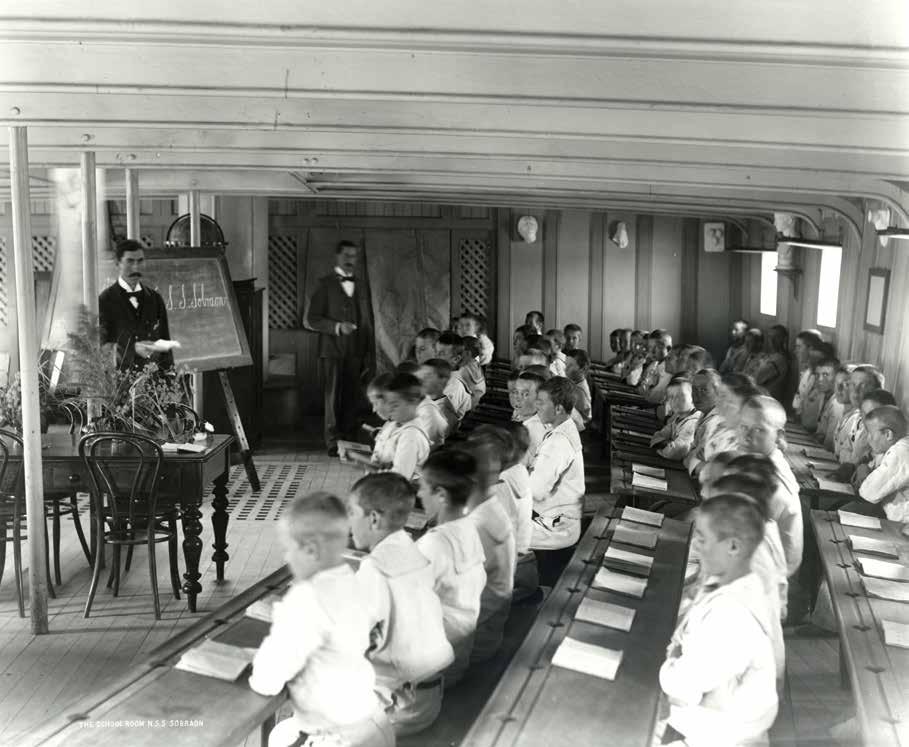
The most popular activity among the boys of Sobraon, surprisingly, was beading; it even extended to boys who were out on apprenticeship
01 Robert Frame’s beaded sampler. ANMM Collection 00015876
02
Boys reading on the Sobraon Image NSW State Archives & Records

A wonderful example of such a sampler exists in the museum’s collection. It is about 8 cm by 40 cm, in the form of a delicate mat with a beaded green, white and red fringe at either end. Surrounded by a blue border is the name ‘NORMAN’, picked out in white beads against a ruby background.
Robert ‘Bob’ Frame
The piece was made by a Sobraon boy named Robert William Frame,6 whose descendant Jean Frame donated it to the museum many years ago. Frame had been brought on board in 1902, aged 13. His parents had been concerned that he had run away from his home in Canterbury. With an accomplice, Frame had used his freedom from parental control to go begging, and then used the proceeds to put himself and his friend up in a hotel. They decided to steal the blankets as they left the next morning. Frame was soon arrested.
While on board, Frame’s best friend was a boy named Norman. A search of boys with either the first name or surname Norman who were concurrent with Frame on the ship has provided too many results to say with certainty which Norman was to be honoured with this gift. But there remain many questions about this piece, beyond the identity of Norman. Why did Frame hold onto the memento, rather than passing it on? Did the boys lose contact? Frame’s father petitioned for his release at the end of 1903, and succeeded in proving he could care for his son. Perhaps Frame had not finished his artwork when he was released, or could not afford to post it to his friend.
Remembering the lessons
This beading obsession extended to boys who were out on apprenticeship. One boy, identified to us only as P J D, wrote to Captain Mason very soon after arriving in his new home, keen to continue the hobby he had learnt on board: 7
I am arrived and like the place very well. I am living out in the bush, and my master and mistress are very kind to me. I am learning to plough and harrow very well, and I ride very well. Mr Holahan is going to learn me how to shoot. Would you kindly get me six penny worth of beads and a photo of the ship? In spring I will get you a young magpie. I had a pet kangaroo given to me to-day and will send it to you if I can. Remember me to W N, and A Y.
Your sincere friend, P J D
He was promptly supplied with beads.
Robert Frame joined the Imperial Force in 1915, and was regarded as an excellent engine driver. In his late 40s he was a postmaster and was travelling the world.
Another boy, Fred Haager, who arrived on board a few years after Frame, had a similarly positive experience. He reminisced that: 8
I have none but very happy memories of the Sobraon Although she was a tight ship, she gave me the happiest years of my boyhood…

Throughout his life, Walpole delighted in meeting law-abiding ex-students, who had learnt many lessons from sport and playing with beads:
Over the years I’ve met many ex ‘Sobraon’ boys on bowling clubs greens or golf links. Many have done well and made a success of their lives.
In 1911 the school was discontinued. Sobraon was repaired, refitted and commissioned as the Royal Australian Navy’s first naval training ship in 1912, and renamed Her Majesty’s Australian Training ship (later HMAS) Tingira. It served in this role until being decommissioned in 1927, then passed through various owners before being broken up and sold in 1941. Its remains are now believed to lie in Berry’s Bay on Sydney’s North Shore, not far from its former mooring beside Cockatoo Island.
1 Ragged Schools were private philanthropic institutions established to give free basic education to poor children in the days before compulsory schooling. They arose in England and Scotland in the early 19th century, and in inner-city Sydney from the mid-1800s. The philosophy of the Ragged School movement was holistic – in the sense that it sought to avoid the ‘removal’ of neglected children from their families, and rather educate both children and parents in their own neighbourhoods. At the height of the movement, more than 500 children were educated across Sydney’s five Ragged Schools each day.
2 ‘The Vernon Training Ship’, Empire, 18 June 1867, p 5.
3 W H Mason, ‘Nautical School Ship Sobraon (Report for the year ended 30 April, 1906)’, New South Wales Legislative Assembly Votes and Proceedings (1906: Vol 1), pp 361–72.
4 F W Neitenstein, ‘Education. Report of the Nautical School-Ship Sobraon for year ended 30 April, 1896’, New South Wales Legislative Assembly Votes and Proceedings (1896: Vol 2), pp 1187–97.
5 G A Walpole, Roses in December (privately published), Gosford Library [LSC 920 WALP].
6 NSWSA&R, NRS 3902, Sobraon Industrial School Entrance Books (8/1749).
7 W H Mason, ‘Education. (Report of the Superintendent of the Nautical School Ship Sobraon for the year ended 30 April, 1898)’, New South Wales Legislative Assembly Votes and Proceedings (1898: Vol 1), pp 1133–51.
8 F Haager, ‘Fred Haager recalls life in the NSS Sobraon ’, The Log , 19 March 1964, pp 35–8.
Further reading
J Ramsland, Children of the Back Lanes (NSW University Press: Kensington, 1986)
Sarah Luke is a freelance historian. Her first book, Callan Park, Hospital for the Insane, was shortlisted for the 2019 NSW Premier’s History Awards. Her history of the Nautical School Ships Vernon and Sobraon, Like a Wicked Noah’s Ark, is due for publication later this year. See sarah-luke.com for details.

Since colonial times, pilots have guided vessels safely into and out of ports throughout New South Wales. Curator of Ocean Science and Technology Emily Jateff looks into the work of the Port Authority of New South Wales and its highly trained pilots.
FROM THE EARLIEST DAYS of the Port Jackson settlement, Watson’s Bay, just inside Sydney Heads, was the home of Sydney’s marine pilots. By 1809, Robert Watson, the ex-quartermaster of First Fleet flagship HMS Sirius, assisted vessels with harbour navigation. Watson’s role was formalised by 1811. Pilotage was initially a private enterprise between local marine pilots and incoming vessels, but by 1833, pilots were required for safe harbour entry and exit on all ships.
On 20 August 1857, 121 people died when the Dunbar went aground just outside Sydney Heads in heavy rain. The public outcry over the horrific event led to the establishment of Sydney’s first permanent pilot station. Early pilot boats were whatever was at hand; whaling boats were the most common. Thetis (built 1868) became the colony’s first dedicated pilot steamer in 1875, when the government took full control of the service.
The second pilot steamer Captain Cook (II) was designed by W D Cruikshank and built at Mort’s Dock & Engineering Company in 1892. Used as a naval training ship during World War II, it was scuttled off Sydney in October 1947. Photographed c 1920 by William James Hall. ANMM Collection ANMS1092[015] Gift from Mr and Mrs Glassford
In 1898, the first of three pilot vessels christened Captain Cook (built 1875) guided just 47 vessels into port in the month of February. More than 100 years later, Sydney marine pilots guide an average of 12 vessels to safe harbour per day.
Modern marine pilots ensure safe navigation into Sydney Harbour via either the Eastern Channel or Western Channel. Commercial vessels can be both hard to manoeuvre and slow to stop, so safe navigation is paramount to preserve life, port infrastructure and the environment.
Pilots oversee container ships going to Port Botany in Sydney’s south, which specialises in bulk liquid imports like petroleum; commercial ships to Port Kembla near Wollongong, which handles increasing motor vehicle imports and grain exports; and bulk carriers to Newcastle Harbour for coal export.
Pilots also bring in cruise ships to the Overseas Passenger Terminal at Circular Quay and the White Bay Cruise Terminal at Rozelle, and to Newcastle, Port Kembla and Eden, on the New South Wales south coast.
Marine pilots use detailed local knowledge of depths, currents and tides to guide shipping through the channels of ports and harbours. After boarding from a cutter four nautical miles from port, they advise the captain of their approach plan and take navigational control until the vessel is safely berthed, although the captain maintains overall command.
Boarding at sea is usually via a ladder thrown over the side –which tests the pilot’s physical endurance in windy and wet conditions. In The Pilot Service of Port Jackson (1902), by John Arthur Barry (available via Project Gutenberg Australia), the author takes a day trip on pilot steamer Captain Cook One of the passengers remarks on the beautiful day and easy sailing, to which the skipper responds:
But what about the pitch-dark nights, with a SE gale, blowing big guns, rain driving in thick squalls, and a scared foreigner burning blue lights and sending up rockets for a pilot off Botany, and not knowing where he is any more than the man in the moon. You should come out with us at a time like that to see what piloting really is! ... No, it’s not all beer and skittles!
Sometimes the weather is fresh enough that pilotage is suspended. At Newcastle it is a different story, however, as most ships entering the harbour are coal and grain ships that have enough deck space to allow pilots to board by helicopter.
Marine pilots are skilled and experienced Master Mariners. Training to be a marine pilot includes successfully completing a series of simulations in a training facility on a replica ship’s bridge complete with control panels and communication equipment. After completion of training, pilots are usually required to have two or more years of piloting experience before taking navigational control of the larger bulk container and cruise ships.
The National Maritime Collection includes models, blueprints, photographs, drawings and audio-visual material related to operational pilot boats and pilotage in Sydney Harbour and greater New South Wales. We also hold an interesting collection of documents and artefacts from the Queensland and Torres Strait Pilot Service.
The museum will open its new glass-fronted Harbourside Observatory and Ben Lexcen Terrace waterfront venue later this year. There visitors will be able to sit and relax while surrounded by the sights, sounds and stories of Sydney’s busy working life above and below the harbour’s waters.
Details on modern marine harbour pilots were provided by The Port Authority of NSW, which is generously supporting the Harbourside Observatory. Further reading
A pilot steamer for the collection, by Michelle Linder (2015) sea.museum/2015/01/07/a-pilot-steamer-for-the-collection Marine pilots keeping ships safe in Sydney for 225 years (2018) portauthoritynsw.com.au/news-and-publications/2018-news/marine-pilotskeeping-ships-safe-in-sydney-for-225-years/ collections.anmm.gov.au/objects/12908/reel-of-sound-recording-of-sydneypilot-service?ctx=7db44a64-3095-48c5-86f2-f1474380f93c&idx=11

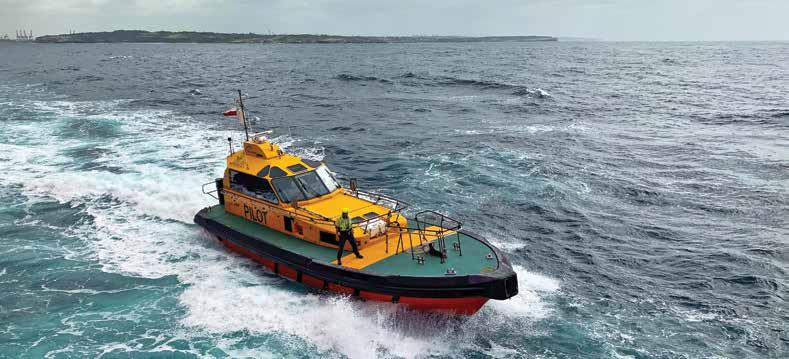
Recovering refugee narratives
7.30–8.30 pm Thursday 18 June
How are refugee memories expressed through the arts and how are they remembered within diasporas? This Ocean Talk features four fascinating speakers who will present insights into their individual stories and how they have recovered refugee narratives through music, theatre, writing, visual arts, filmmaking and photography.
Free. Register your attendance online at sea.museum/ocean-talks
Ocean defenders
7.30–8.30 pm Thursday 6 August
This Ocean Talk will address how the health of our rivers, streams, oceans and seas stands as our island nation’s biggest challenge and most important objective. Hear from some of the country’s most important ocean defenders and innovators as they work to address the most critical issues of the 21st century. Discover how what we do will have a real and lasting impact on the health of Australia’s and the world’s waterways for decades and even generations to come. The panel will be moderated by the museum’s Curator of Ocean Science and Technology, Emily Jateff. Speakers are yet to be confirmed; please check our website for updates.
Free. Register your attendance online at sea.museum/ocean-talks
Many of our regular activities have been paused until the government restrictions change and the museum is approved to recommence its onsite programs. We can’t wait to share these with you again soon. To keep up to date on when our programs will restart, subscribe to our online family newsletter at sea.museum or our social channels @sea.museum.
And in the meantime, keep the family entertained and school-age children learning with our online offerings outlined below.
Virtual Ocean Talk
Indigenous Sea Rangers
7.30–8.30 pm Thursday 2 July
This talk and its speakers are still being finalised; please see our website for details.
Free. Register your attendance online at sea.museum/ocean-talks
As Signals goes to press, the museum is reopening on 22 June, but our public programs and on-site events remain suspended. Please check sea.museum/ whats-on for updates on when we will resume our normal schedule of talks, tours and activities. For online assets such as our collections, Signals archive, blog and more, visit sea.museum/discover.
Virtual Ocean Talk
A fish-eye view of Warrane/Sydney Harbour
7.30–8.30 pm Thursday 10 September
This panel session will map a critical framework for exploring sustainability of species in Sydney Harbour in the past and into the future. Leading harbour voices will explore the history of fishing in the harbour from colonial to modern times, and present a rich public art program that draws attention to European overfishing. The panel will also explore sustainable fisheries and invasive species. Moderated by the museum’s Senior Curator Daina Fletcher, panellists will include former senator John Faulkner, independent curator, writer and educator Emily McDaniel and marine biologist Professor David Booth. Free. Register your attendance online at sea.museum/ocean-talks
Visit sea.museum/kidscraft to find a whole host of online creative activities to keep families entertained and learning through making. Choose from recipes, science experiments, soft sculptures, printable papercrafts and activity sheets.
Online learning
Learn at home resources
Visit sea.museum/learn-from-home to explore our newly developed series of online resources for students, teachers and parents, to help guide students’ learning. From educational games to blogs, videos and response activities, there’s something for all ages and stages to engage with.

From the Pacific to the Islands of Indonesia, ocean voyagers had been traversing and navigating around the coasts of Australia for centuries before Europeans arrived. The first navigators were Aboriginal people who crossed the seas to arrive in Australia more than 60,000 years ago – the oldest known ocean migration in the world.
INCREDIBLE FEATS OF NAVIGATION were not the sole preserve of Europeans, but were part of a global current of trade, migration and voyaging – all made possible by skills and technologies that understood wind, water and stars. This new permanent gallery tells the stories of navigators under the southern skies using objects from the National Maritime Collection. These include bark paintings that depict Makassan fishermen trading with Indigenous communities in the Northern Territory, and sextants, compasses and telescopes that show the technological advancement in navigational instruments. Also temporarily on display later this year, on loan from the National Library of Australia, are the ‘secret instructions’ that were issued to James Cook, outlining his mission aboard HMB Endeavour
sea.museum/under-southern-skies

Wildlife Photographer of the Year Online now; at the museum until February 2021
This world-renowned exhibition features 100 awe-inspiring images, from fascinating animal behaviour to breathtaking landscapes. Wildlife Photographer of the Year is the most prestigious photographic event of its kind, providing a global platform that has showcased the natural world’s most astonishing and challenging sights for more than 50 years. Wildlife Photographer of the Year is developed and produced by the Natural History Museum, London.
sea.museum/wildlife
Pondworld by Manuel Plaickner (Italy). © Manuel Plaickner/Wildlife Photographer of the Year
Photographs by Michael Cook Online now
Michael Cook’s artworks shift roles and perspectives around the notion of European ‘discovery’ of Australia, reflecting upon our habitual ways of thinking about and seeing our history.
This series questions who really discovered Australia, while making reference to what was always here, what has been introduced and the effect this has had on Aboriginal and Torres Strait Islander people, culture and country. A selection of images is shown online.
sea.museum/michael-cook-undiscovered
now
A digital exhibition of stunning black-andwhite photographs shot by internationally acclaimed Sydney photographer Paul Freeman, who is famous for his nude portraits of sports stars.
This series of images was commissioned for the Sydney Gay Games VI in 2002. The Gay Games, which started in San Francisco in 1982, are held every four years and are organised by the LGBTQI community around the themes Sports, Arts & Culture and Academic Conference.
sea.museum/seaofrainbow
Scott Gustetter: swimmer, 2002. ANMM Collection NC701231, © Paul Freeman. Reproduced courtesy of Paul Freeman
now
It is estimated that between 12,000 and 15,000 Australian women married American servicemen during World War II. Some made a life in the USA, while others returned to Australia with or without their husbands in the years following the war. While public perception about war brides paints a narrow picture, it is clear that there are many different reasons why Australian women married American servicemen.
sea.museum/war-brides
Since the First Fleet dropped anchor in Sydney Cove in 1788, close to 10 million settlers have moved from across the world to start a new life in Australia.
They have arrived in waves, encouraged by events like the 1850s gold rushes, or to escape adverse conditions at home, including the social upheavals of the Industrial Revolution in 19th-century Britain, the two world wars and the aftermath of the Vietnam War in the 1970s. Collectively these migrants have helped shape a unique society – one formerly British-based, but now multicultural and on the perimeter of Asia.
sea.museum/waves

now
From the 1860s, more than 100,000 children were sent from Britain to Canada, Australia and other Commonwealth countries through child migration schemes.
The lives of these children changed dramatically and fortunes varied. Some succeeded in creating new futures; others suffered lonely, brutal childhoods. All experienced disruption and separation from family and homeland.
sea.museum/britainschildmigrants

War and Peace in the Pacific 75
Online now
An online exhibition delving into the events and impact of the Pacific War on the battlefront and at home, 75 years after they occurred.
Australian, Japanese and US perspectives highlight the immense impact of the war on everyone it touched.
sea.museum/warandpeace
From July
James Cook mapped the east coast of Australia aboard the Endeavour in 1770, and this year marks 250 years since that historic voyage.
Through a series of curated banners in the Wharf 7 forecourt, we examine this event and its legacy, incorporating perspectives of both those aboard the Endeavour and the Indigenous inhabitants watching it from the shore.
It was a pivotal moment when two cultures –neither able to communicate or comprehend the other’s world – collided with near fatal consequences for the Indigenous custodians of the land and their 60,000-year-old culture.
sea.museum/ship-and-shore
Online now; at the museum until 11 October
An exhibition combining real fossils, gigantic replicas, multimedia and hands-on experiences to reveal ancient monsters of the deep. Find out how three main types of ancient reptiles – ichthyosaurs, plesiosaurs and mosasaurs – left the land to rule the seas. In the oceans, they developed into awesome, enormous predators that make today’s great white sharks seem almost friendly!
sea.museum/sea-monsters
Cook and the Pacific July to September
Drawn from the National Library of Australia’s major 2018–19 international exhibition comes this travelling, multimedia display.
When you visit Cook and the Pacific, you’ll follow James Cook’s three remarkable Pacific voyages and explore this spectacular region through the eyes of the British voyagers and the First Nations peoples they met.
The exhibition takes visitors on a journey to the Pacific 250 years ago, with destinations including Tahiti, New Zealand, the east coast of Australia and Hawaii. Included are images of maps, manuscripts, rare books, oil paintings and watercolours by voyage artists.
sea.museum/cook-and-the-pacific
Until November
HERE: Kupe to Cook features artworks by 20 leading Aotearoa–New Zealand and Australian contemporary artists who investigate the long and varied histories of South Pacific voyaging – from celebrated Oceanic navigator Kupe to the arrival of James Cook in 1769.
Maori sculptors Wi Taepa and Tawhai Rickard have created sculptural interpretations of Kupe’s anchor stone and an imagined version of Cook’s ship HMB Endeavour Paintings inspired by Tongan Ngatu barkcloth by Glen Wolfgramm and Dame Robyn White celebrate connections between Oceanic communities, while photographs by Samoan artists Yuki Kihara and Greg Semu question the strength of those connections.
Produced by Pataka Art + Museum in association with the National Library of New Zealand sea.museum/kupe-to-cook
Dates listed above for on-site exhibitions are subject to the museum reopening, and may change at short notice.
Our travelling exhibition program is temporarily suspended. Please check our website sea.museum for updates.
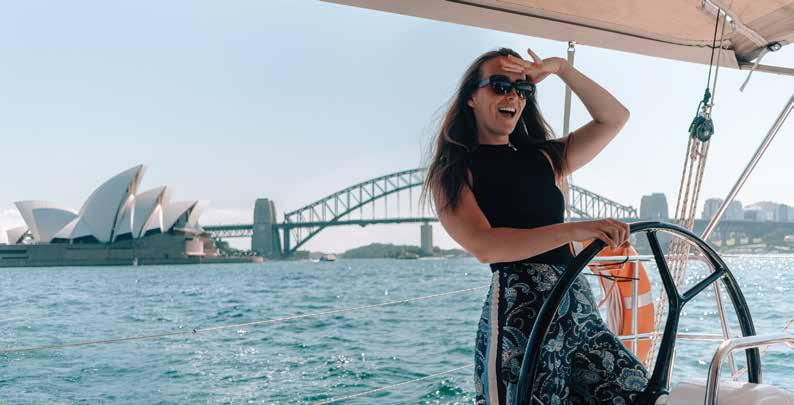
Prepare for the future when you, your family and friends can once again enjoy time aboard a luxury yacht on Sydney Harbour. Purchase a voucher of any value before 30 June and we will double it.
All vouchers are redeemable on any of our activities for 12 months. Contact us now for further details at info@sydneybysail.com or 02 9280 1110.


Botanist Joseph Banks wrote in his journal that the local Indigenous people seemed to have lost all fear of the crew and reported that the two groups had become friends
Reconciliation Rocks in Cooktown, Queensland, is a remarkable place where, in 1770, Australia’s first act of reconciliation recorded by Europeans took place. This largely untold and unknown story is one of two cultures settling their differences after a cultural misunderstanding to restore peace and mutual respect. By Tracey Toovey and Jane Alexander of the National Trust of Australia (Queensland).
HMB Endeavour catastrophically struck the Great Barrier Reef 24 kilometres east of the Kuku Yalanji country, which extends from the Annan River south of Cooktown and incorporates Cape Tribulation and the Daintree Rainforest towards Cairns. The ship then limped 50 kilometres up the coast looking for a safe haven to careen and repair the damage. From the moment they entered the mouth of Waalumbal Birri (now known as the Endeavour River), Cook and his crew were being carefully watched by the Indigenous people of the area, known as the Bama, from many vantage points across the river.
The weather and prevailing trade winds forced Cook’s crew to stay safe inside the Endeavour River for 49 days. A month after Endeavour arrived, on 10 July, the cautious Bama finally made contact in a meeting that was by all accounts uneventful.
A short while later botanist Joseph Banks wrote in his journal that the local Indigenous people seemed to have lost all fear of the crew and reported that the two groups had become friends. He described a spear-throwing demonstration and commented that the Bama boarded the ship soon afterwards, on 18 July 1770.
Cook mentions in his journals that when a group of men from the Guugu Yimidhirr nation went aboard Endeavour, they weren’t interested in anything except for the dozen or so turtles lying on the deck of the ship, which Cook’s men had captured earlier. The Bama had prescribed teachings on how many turtles could be taken, and from where; but Cook’s men, by gathering as many turtles as possible to supply their lengthy return journey to England, inadvertently deeply offended the local Indigenous people. It is believed that the Guugu Yimidhirr people called a meeting that night to discuss in earnest what should be done about the taking of so many turtles. They believed in only ever taking what you needed to survive, so they were extremely angry.
Cook claims in his journal that a couple of the ‘savages’ tried to steal a turtle. The local Indigenous people’s translation of this story, however, tells us that they were actually trying to release it because it was a maarmingu (female turtle) and vital to continued resources in the area. The Bama struggled to get the turtle back into the sea, as each time they tried to drag it to the side of the ship they were stopped by the marines and crew.
Cook’s men, by gathering as many turtles as possible to supply their lengthy return journey to England, inadvertently deeply offended the local Indigenous people


Cook had the presence of mind to understand that the broken spear, rendered completely useless as a weapon, was a symbol of peace
01 Reconciliation Rocks, Cooktown, QLD, 2018. Image Richard Ferguson
02
The reconciliation, by Jane Dennis, 2015.

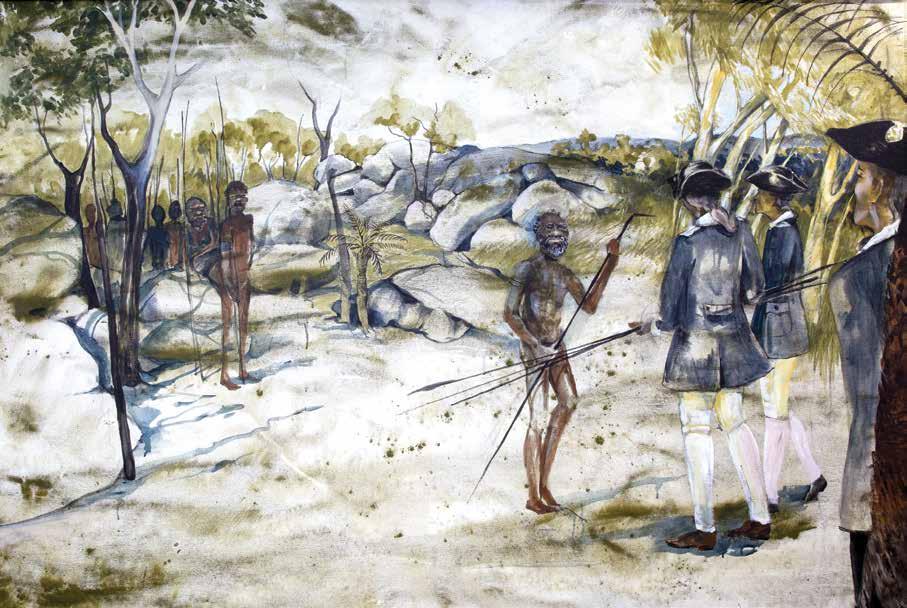
The oral stories handed down by the Bama people about this event perfectly match the entries contained in the diaries of Cook, Banks and Solander
A skirmish broke out before the Bama returned to shore and set fire to the grass surrounding the crew’s tents, nets and supplies. After putting out the fire, Cook retaliated by shooting at the Bama and one of them was wounded. Cook and some of his men chased them for more than a kilometre along the water’s edge, to the spot where two extraordinarily different cultures reconciled. The Bama people sat down about 100 metres away from Cook and one of their elders, a man known as Yabaarrigu, or the ‘Little Old Man’, stepped towards Cook carrying a broken spear.
Cook had the presence of mind to understand that the broken spear, rendered completely useless as a weapon, was a symbol of peace. Wiping sweat from under his arm and blowing it towards Cook, Yabaarrigu also demonstrated a cultural welcome custom. By masking people with their sweat, the Bama believed that spirits of the ancestors then recognised the people as part of the clan or tribe. This ritual also suggests that the spirits will then look after the people, holding them tight and keeping them safe. This was a defining moment in Australian history, as the ‘Little Old Man’ was welcoming Cook as dhawun (a friend). Even though Cook had desecrated the land by intentionally spilling blood, the Bama elder knew he had to stop further desecration without bloodshed and so he asserted the cultural governance of the area.
Banks later wrote that the crew beckoned to the elder to come even closer. Yabaarrigu then spoke to his tribe, who all laid their spears against a tree and came forward. In his journal, Cook noted ‘and all was then reconciled’. Three weeks later, at 7 am on 4 August, with a light breeze under sail, Endeavour left the region.
The oral stories handed down by the Bama people about this event perfectly match the entries contained in the diaries of Cook, Banks and Solander; each corroborates the other.
Local Bama man Harold Ludwick, from the Guugu Yanidhirr people of southern Cape York, works in Cooktown at the National Trust’s James Cook Museum as a museum guide and cultural advocacy officer. He says that Reconciliation Rocks is a special place, whose story is very significant for Australia: It is sacred to our people because it is where peace was negotiated between two very different cultures that recognised the value of reconciling differences, and in this story lies the ‘blueprint’ for overcoming disharmony, which can be utilised in our nation today to progress without hate. It is vitally important because we have been working hard to mend this country … it is the pedestal for both cultures to unite in a way that Australia hasn’t united since 1770. This could be the nucleus for other places to take notice of what can be achieved. It proves that cultures can exist side by side. To respect all cultures inspires a nation.
This unique site has recently been nominated for the National Heritage List. There are currently only 116 places on this list, which aims to encompass sites that reveal the richness of Australia’s extraordinarily diverse heritage and that contribute to our national identity. It includes places such as the Sydney Opera House, Uluru and the Melbourne Cricket Ground. These are the places that tell the story of Australia and Australians and help form our national identity.
The joint nomination by the Hope Vale Congress Aboriginal Association and National Trust Queensland aims to fill a gap in the list with regards to places of Indigenous heritage and those that represent reconciliation and mutual understanding between cultures. Reconciliation Rocks is a significant location that makes us consider what reconciliation means to us as individuals and why it is so important for the future of our country.
‘We can’t change the past. We all have a history, but here in Cooktown we have chosen to show a balance.’
Cooktown Bama Aunty Alberta Hornsby
The National Trust of Australia James Cook Museum, Cooktown, displays and interprets the story of reconciliation and Endeavour ’s grounding on the Great Barrier Reef. It displays two very large artefacts that were on board Endeavour : the bower anchor, kindly on loan from the National Museum of Australia, and one of the six four-pounder cannons that was jettisoned after the ship ran aground. These were retrieved over several marine archaeological expeditions between 1969 and 1971.
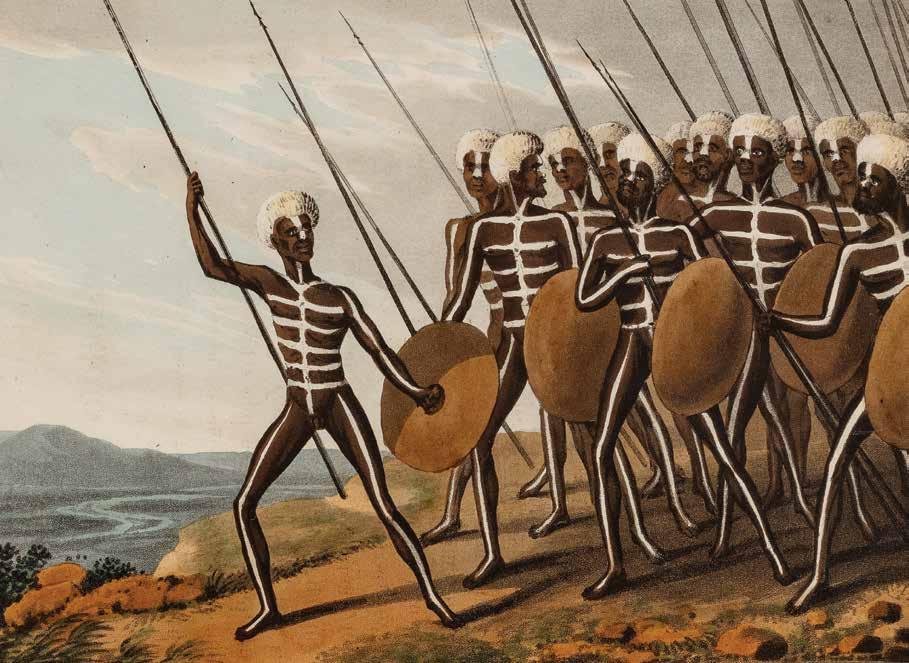
A series of aquatints recently acquired by the museum sheds light on how Aboriginal people were viewed by Europeans in the early days of colonial New South Wales, and also offers some interesting further research potential, write curators Dr Stephen Gapps and David O’Sullivan.
01
Warriors of NSW depicts some elements of documented accounts of warriors preparing for combat, but some, such as shields, are fictional. ANMM Collection 000202131
All images Andrew Frolows/ANMM 02
The Dance shows members of an unknown community performing and watching a corroboree. ANMM Collection 000202131
These scenes of Aboriginal life tell us much about the way colonisers viewed Aboriginal people
JOHN HEAVISIDE CLARK (c 1771–1863) was a Scottish aquatint engraver and painter, best known for his seascapes and landscapes. He exhibited regularly at the Royal Academy in London between 1812 and 1832 and was the author of A practical essay on the art of Colouring and Painting Landscapes, published in 1807. Clark came to particular prominence for his role as an early form of war correspondent, taking sketches in the field immediately following the Battle of Waterloo in 1815. This gained him the nickname ‘Waterloo Clark’.1
How did a man known as ‘Waterloo Clark’ end up producing a series of images of Aboriginal Australians? Clark is not known to have ever set foot in the country. The answer may lie in his connection to, and sympathy for, one of the most divisive and enigmatic figures in Australian history – William Bligh.
Clark’s Field Sports of the Native Inhabitants of New South Wales was published in 1813 as a supplement to a broader work, Foreign Field Sports, Fisheries, Sporting Anecdotes, etc, that contained 100 illustrations. Images of foreign lands, particularly exotic cultures in the Pacific and Asia, were increasingly popular in Europe at this time, and it seems that Clark was producing works for this growing mass market.
Aquatints were a relatively quick way to produce printed images that looked like watercolours. The aquatint, as a process of etching to make prints, had been employed in various forms since the mid-17th century. Rather than a more twodimensional black and white engraving, the hand-coloured aquatint emphasised tones and shading, adding a colourful realism not matched in print form until the beginnings of colour photography in 1907. 2
Clark’s aquatints are almost certainly based on earlier watercolours by John William Lewin (1770–1819), an artist and naturalist who had arrived in the colony of New South Wales in 1800 and would soon become one of its leading artists. Lewin was highly regarded for his paintings of natural history subjects and of Aboriginal people. One of these is the wellknown image of a ‘chief’ at Bathurst, thought to be the famous resistance leader Windradyne. Unfortunately, few of his images of Aboriginal people have survived.

Lewin was well acquainted with the Scottish naval officer James Grant (1772–1833), sailing with him on the Lady Nelson in 1801 to the Hunter River in New South Wales and to Bass Strait. Intriguingly, Lewin was among the land-owning settlers who, after the infamous so-called ‘Rum Rebellion’ of 1808, supported Governor William Bligh, who was overthrown by the New South Wales Corps and John Macarthur and his supporters. Lewin was among the signatories to a petition in May 1808 expressing alarm at the arrest of the colony’s governor.
When published in 1813, Clark’s Field Sports series of 10 images was dedicated to William Bligh. By this time, the court-martial of the coup’s military leader, Major George Johnston, had cleared Bligh’s name of ‘tyranny’, but opinions were still divided about the character of the governor who had two mutinies to his name – the other being that on the Bounty in 1789. The Field Sports dedication to Bligh hoped the former governor would keep alive: 3 … the recollection of a distant spot, where your exertions for your country, and for the benefit of mankind, have been so eminently displayed.
Clark obviously had no doubts as to the service and character of a figure who is still hotly debated to this day. The links between these contemporaries – Lewin, Grant, Bligh and Clark – will be a focus for future curatorial research. It will be interesting to explore any connection between Clark’s family and John Heaviside (1748–1828), who was surgeon to King George III.
The hand-coloured aquatint emphasised tones and shading, adding a colourful realism not matched in print form until the beginnings of colour photography in 1907
01
Hunting the Kangaroo reflects European ideas of shape and form, with strange bulbous flowers and oddly canine kangaroos in a stylised depiction of the Australian landscape. ANMM Collection 000202131
02
Fishing suggests that Clark had some knowledge about the watercraft and fishing methods of Aboriginal people in the Sydney region. ANMM Collection 000202131
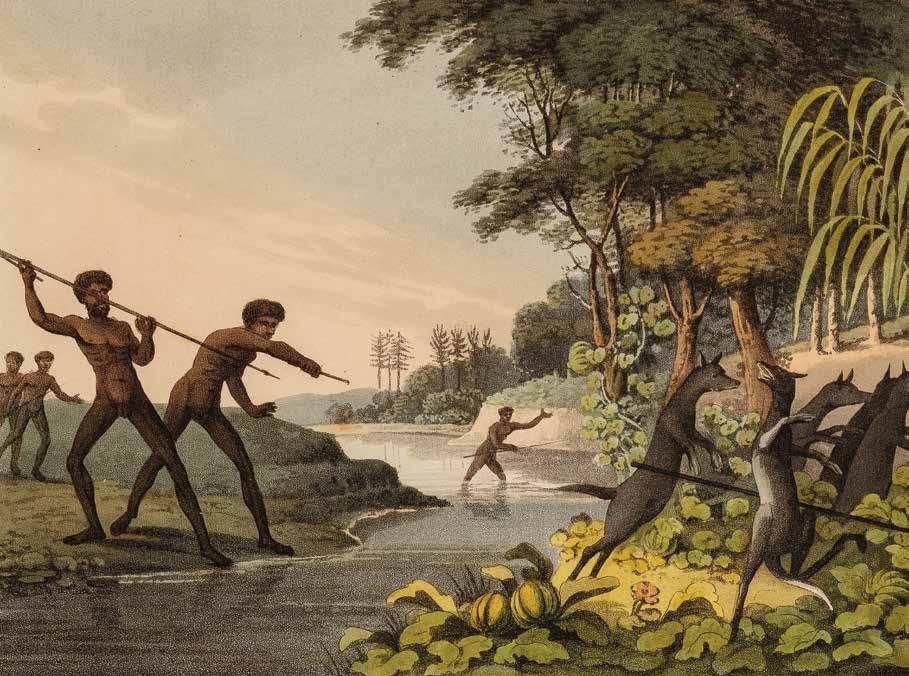

Of particular interest to curators at the museum is the aquatint titled Fishing. Certain features suggest that Clark had other images or information about the watercraft and fishing methods of Aboriginal people in the Sydney region, as the canoe in the background is certainly reminiscent of the local tied-bark nawi. The role of women as the key fishers from nawi is also consistent with accounts in early colonial journals. The strange counterbalancing action and construction of the nawi in the foreground, however, show some imagination at work.
Early colonial images of Aboriginal people can contain important historical information. They should never be viewed as true lenses into the past, however, and in particular into Aboriginal culture at that time. More often than not, they are distorted views, and often exist now more as documents of European sensibilities than actual history. For example, the locations in Clark’s series are difficult to identify, making it almost impossible to tell which communities are portrayed. So, too, his depictions of flora and fauna – as seen in the odd-looking kangaroo and bulbous flowers in Hunting the Kangaroo. These aquatints are obviously stylised and reflect European ideas of shape and form, rather than any realistic image of the Australian landscape. Not until the late 19th century did colonial artists break away from their European style and method and began to more fully understand – and express a less filtered view of – the Australian landscape and its First Peoples.
Clark’s images were popular, and were reprinted a number of times after 1813. This series has been suggested as dating from 1818, but further detailed investigation of the works awaits. Initial analysis by curators and conservators indicates that they are certainly one of the early printed versions.
The collection will be an important acquisition for the museum. These scenes of Aboriginal life tell us much about the way colonisers viewed Aboriginal people. Clark himself failed to see Aboriginal culture and society as productive: 4
Though the general character of the natives of New South Wales is a compound of inconsistencies, there is no reason to despair of their becoming, at no very distant period, useful members of society.
The series is also important because, despite being often recycled as images of pre-contact Aboriginal society, there has been surprisingly little research into their production –particularly the connections between the artist Clark and his contemporaries Lewin, Grant and Bligh.
1 Michael Bryan and Robert Edmund Graves (eds), Dictionary of Painters and Engravers: Biographical and Critical. London: George Bell and Sons, 1886, p 280.
2 Ives Colta, ‘The Printed Image in the West: Aquatint.’ In Heilbrunn Timeline of Art History. New York: The Metropolitan Museum of Art, 2000, metmuseum.org/toah/hd/aqtn/hd_aqtn.htm (October 2003).
3 John Heaviside Clark, Field Sports of the Native Inhabitants of New South Wales: with ten plates by the author. London: Edward Orme, 1813, p 2. 4 Clark, p 25.
Some works by Aboriginal and Torres Strait Islander artists intentionally appropriate, echo and ultimately subvert well-worn colonial imagery
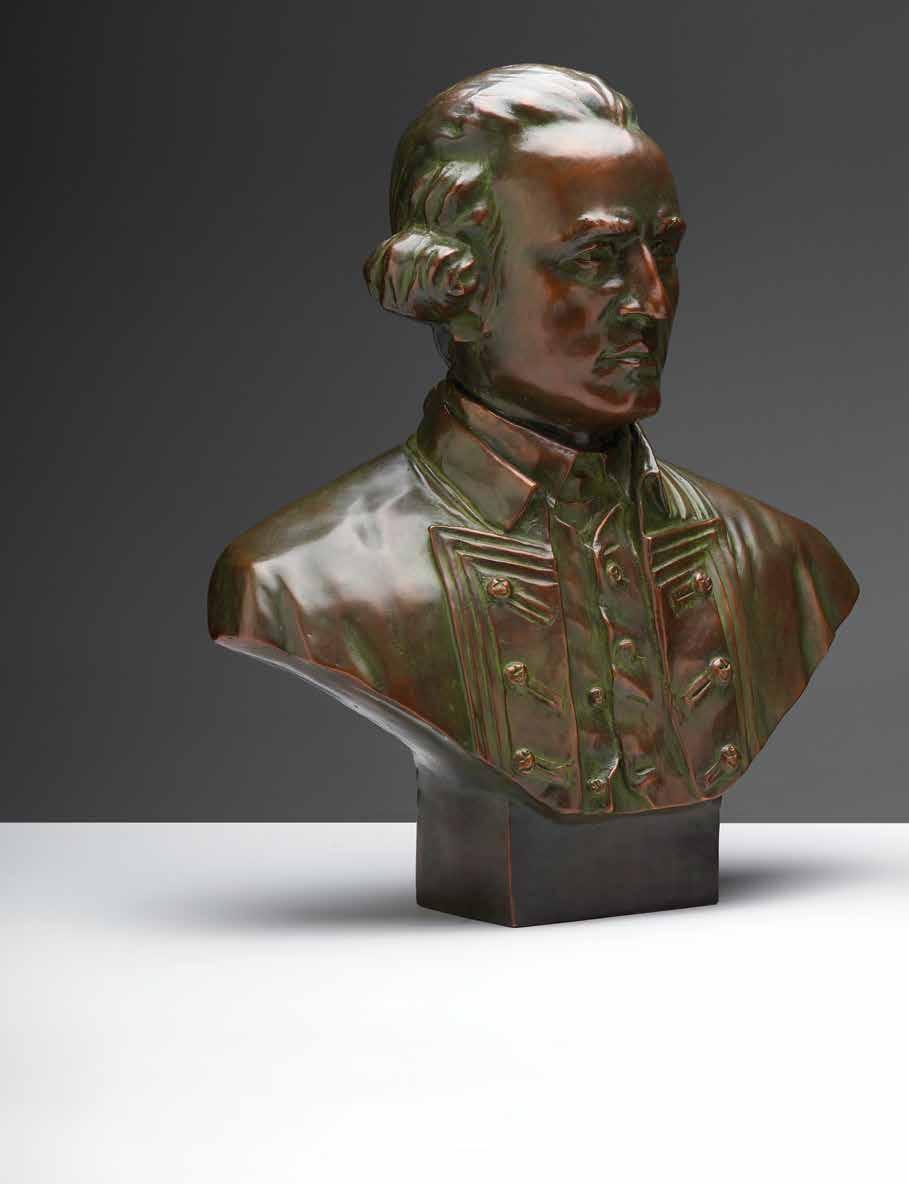
‘Too many Captain Cooks’
The museum’s Indigenous contemporary art collection

As we commemorate the 250th anniversary of the arrival of HMB Endeavour on the east coast of Australia, Head of Indigenous Programs Beau James and Acting Head of Research Dr Stephen Gapps look back on the museum’s Indigenous collections, and look forward to new ways of seeing the momentous events of 1770.
JAMES COOK AND THE ENDEAVOUR did not stay long on Australian shores, and the first moment of colonial occupation was 18 years later, in January 1788 – but despite this, Cook has had a huge symbolic role in the modern Australian nation. The British navigator has also remained persistent in Aboriginal memory, often in country far away from the east coast. Why does Cook stand in for many other instances of colonisation? How does Cook transcend time and space to, as Worimi man and historian John Maynard puts it, ‘wreak havoc across the continent’ and remain ‘a scapegoat for white invasion’?
Some insight into these questions can be found in the museum’s collections and exhibitions. One of the most important artworks in the collection is Paddy Fordham Wainburranga’s Too many Captain Cooks (1993). In the 1980s Paddy was painting the Captain Cook story of his Rembarrnga–Ngalkbun people from Arnhem Land in northern Australia. This artwork was one of a number of stories told from an Aboriginal perspective that were being produced at a time when the non-Indigenous community was celebrating 200 years since the arrival of the 1788 fleet – the Bicentenary of 1988. Paddy’s historical paintings incorporated events, themes and iconography from both Aboriginal and European cultures and quickly won wide acclaim.1
In Paddy’s work, an alternative Aboriginal version of Cook emerged in the wider Australian consciousness – one that represented other moments of encounter and dispossession right around the country. In the 1988 documentary film Too many Captain Cooks, Paddy explained how there were ‘Captain Cooks’ all over the country, or as he said it, ‘one Captain Cook; all different places’. This unusual view of Cook took non-Indigenous Australians by surprise. It challenged historical sensibilities. But it also made sense. Cook stood in for many historical narratives of cross-cultural interaction with colonisers across Australia, just as he had stood in for 200 years of discovery and foundation narratives for European Australians.
Since opening in 1991, the museum has collected material associated with Cook’s three major voyages, including published accounts, maps, charts and ephemera surrounding the commemoration of the famous navigator. When the replica ship HMB Endeavour was offered to the museum in 2005, there was little doubt that this was the logical place for such a finely made reproduction of an 18th-century sailing vessel to be held.
Yet at the same time as the museum took custody of the replica Endeavour, it also made a priority of collecting contemporary Indigenous artists’ responses to the histories of European contact, invasion and the subsequent long history of violence, resistance and colonisation. This collecting policy in many ways reflected the changing nature of symbolic contests over Cook in broader Australian society. It also reflected new ways of interpreting these histories, firmly acknowledging the voices that have been left out of the stories around the arrival of the Endeavour in particular.
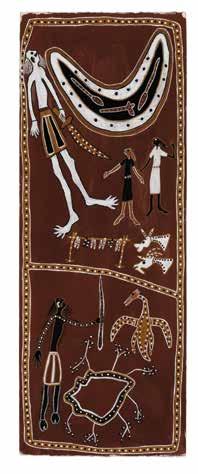
01
In Too Many Captain Cooks (1993), Paddy Fordham Wainburranga tells the story of Badaparr, the custodian of the country, who is likened to Captain James Cook. Badaparr and the devil Lungi Ngyan (Ngayang Lunji) fought and the body of the devil was thrown, creating Sydney Harbour. ANMM Collection 00017992
02
Black Bastards are Coming! (2013) by Gordon Syron reverses the roles of colonisers and those whose land they invaded. ANMM Collection 00054536
Our museum is comparatively young, not burdened with the collecting practices of institutions in the 19th century that took Indigenous art, artefacts and even human remains without permission or consideration of the long-term effect on Aboriginal communities. These early museums were implicitly involved in the long period of colonial violence against Indigenous people across Australia and around the Pacific. While the museum was founded in the 1980s with an over-representation of colonial objects and narratives, in many ways it expressed changing attitudes to history over the last 30 years or so, particularly to the old narratives of what constitutes ‘maritime history’. In the past, collecting objects associated with what were once regarded as ‘foundation’ moments – such as Cook and the First Fleet –was regarded as the main role of a national museum, but our museum began to shift its focus in the 1990s. The social history of swimming, surfing and boating, the industrial history of the waterfront, the history of migration and the environmental histories of our rivers and oceans all became collecting priorities.


At the museum, Indigenous curators have begun to lead the development of collections and exhibitions
Added to this are the maritime histories of Aboriginal and Torres Strait Islander peoples, their saltwater and freshwater stories. This is now expanding to other Indigenous communities especially across the Pacific. Throughout the 1990s the museum – which in its initial conception did not include an Indigenous gallery or display – developed the Eora gallery to showcase Aboriginal and Torres Strait Islander artwork and cultural artefacts. In 1998 the museum acquired the important Saltwater Collection – bark paintings of sea country in northeast Arnhem Land. Close to 80 barks were made by Yolŋu artists to document their claims to sea rights prior to the famous Blue Mud Bay High Court decision of 2008, which granted traditional owners native title rights to their fishing grounds. The Saltwater Barks – most recently displayed in the exhibition Gapu-Mon_uk Saltwater – Journey to Sea Country – were in effect Yolŋu title deeds to their sea country and are one of Australia’s most significant collections of bark paintings (see Signals 60 and 123).
The National Maritime Museum now flies the Blue Mud Bay Sea Rights flag each day.
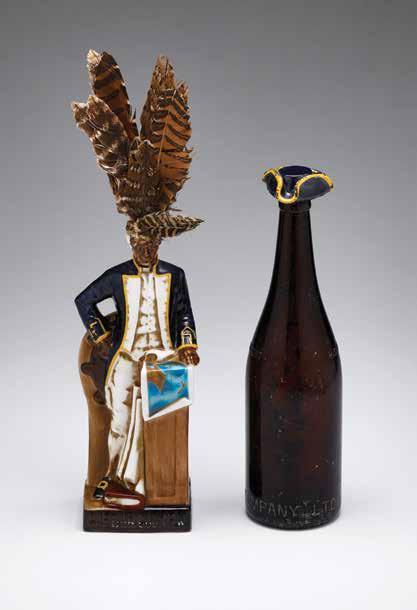
By the early 2000s, there was a growing realisation at the museum that Aboriginal and Torres Strait Islander histories and relationship to sea and river country had often been overlooked. After many years of land rights campaigns, Australians were beginning to understand First Nations peoples’ deep relationship to land, but few thought of this as a totality of land, waterways and sky. No Australian museums focused on First Peoples’ relationships to, and histories of, water, a relationship that had been clearly shown in legal terms in the Blue Mud Bay case and other native title cases such as Yaegl and Byron Bay Bundjalung. With the employment of Indigenous staff in a dedicated Indigenous Programs Unit, in 2012 the museum embarked on its first Nawi – Exploring Australia’s Indigenous Watercraft conference and associated programs in building traditional watercraft and reviving skills 2 (see Signals 100 and 101).
At the museum, Indigenous curators have begun to lead the development of collections and exhibitions, rather than having to respond to non-Indigenous-led narratives. Since 2014, the museum’s Head of Indigenous Programs, Beau James, has added to the museum’s collection of important works by prominent Aboriginal and Torres Strait Islander artists, including Gordon Syron, Ken Thaiday Snr, Fiona Foley, Adam Hill, Paddy Fordham Wainburranga, Michael Cook, Karla Dickens, Jason Wing, Alick Tipoti, Bunduk Marika and Gail Mabo. Many of these works critique historical encounters between Aboriginal people and Europeans. Some, such as Helen Tiernan’s series Colonial Wallpapers and Colonial Heroes, intentionally appropriate, echo and ultimately subvert well-worn colonial imagery. Others such as Gordon Syron’s Black Bastards are Coming! are direct political commentary, reversing the role of invader and invaded.
In the 18th and 19th centuries, colonial artists represented Indigenous subjects and their societies as exotic or scientific curiosities. We now understand that these artworks have their origins in a time when Europeans saw themselves as superior to other races around the world. But these colonial artists also made Cook into a hero, bringing enlightenment and ‘civilisation’ to Indigenous peoples. Strangely, perhaps, we still use these stock-standard images as if they were historical records of Cook stepping ashore at places such as Kamay–Botany Bay. These images of Cook live on in their constant recycling, re-enactment and reproductions. We still show Cook again and again in the heroic poses in which he was imaginatively constructed in the past.
However, the Indigenous view of Cook in contemporary Australian First Nations art is very different. It is based in the long and continuous memory and story of Cook among Australia’s Aboriginal and Torres Strait Islander peoples. Unlike colonial art, it is not stuck in an age where a land with people could be called empty – terra nullius – and where this idea could form the basis of a long-held legal fiction. It is a continuum of First Peoples’ presence, part of tradition, expressing old stories and reminding us that these encounter moments still weigh heavily on the present. This is an important reason why the museum has been collecting strongly in this area in recent years.
Another prominent artist in the museum’s collection is Karla Dickens. Her The nips are getting bigger / I’d better go and get somethin’ harder is a series of Captain Cook whiskey bottles in various guises, a statement about the symbolic and historical legacy of Cook. Similar to Paddy Wainburranga’s depiction of Cook in various roles or modes of colonisation, each bottle has a different ‘Cook’ story.
Other powerful and evocative works in the National Maritime Collection are the haunting juxtapositions of colonial imagery and Indigenous perspectives in Michael Cook’s Undiscovered series. Responses to Cook by non-Indigenous artists such as Reg Mombasa are also important examples of how Australian attitudes to these histories have changed over time. Examples of posters and other protest artwork are included in the collection as well.
One of the most prominent recent acquisitions by the museum has been Jason Wing’s bust Captain James Crook. It is a strong challenge to old ways of seeing. As Bruce Buchan and Eddie Synot recently noted: 3
The growing First Nations challenge to Cook’s iconography highlights his continued presence in our nation’s colonial mythology. It is a challenge to Cook’s elevation as hero of the modern Australia built on Indigenous erasure. Jason Wing’s bronze bust of a balaclava-wearing Captain James Crook symbolises that challenge.
Particularly since the explosion of protest generated firstly from the Cook re-enactment of 1970, then from the Bicentenary of 1988, First Nations artists have increasingly challenged our understandings of Cook: of discovery, possession, invasion and colonisation. These responses have been at the forefront of wider political challenges and historical re-imaginings.
Truth-telling demands that Aboriginal voices be heard, and that non-Aboriginal Australians listen and critique their own ‘foundational’ moments, especially ones built upon the dispossession of others.
Paddy Wainburranga’s story Too Many Captain Cooks made an important point. For Paddy, the ‘old Captain Cook’ did not cause the grief and pain that his people experienced since 1770. Rather, it was the ‘new Captain Cooks’ who followed in his footsteps. Paddy’s words still resonate today:
I’ve finished with the story of old Captain Cook. I’m talking now about all the new Captain Cooks. When the old people died, other people started thinking they could make Captain Cook another way. New people. Maybe all his sons. Too many Captain Cooks. They started shooting people then. New Captain Cook people. Those are the people that made war when Captain Cook died …
1 Susan Lowish, ‘Too Many Cooks’, in Plotting the island: dreams, discovery and disaster, University of Melbourne, Victoria, 2017, p 32. See also Christina Williamson and Rodney Harrison, ‘Too many Captain Cooks?’ in After Captain Cook: The archaeology of the recent Indigenous past in Australia, Rowman and Littlefield, 2002, p 3; Deborah Bird Rose, ‘The saga of Captain Cook: Morality in Aboriginal and European law’, Australian Aboriginal Studies , No 2, 1984, pp 24–39; John M Maynard, ‘”I’m Captain Cooked”’, Cook and the Pacific , National Library of Australia, Canberra, 2018, p 3.
2 Stephen Gapps and Mariko Smith, ‘Nawi – Exploring Australia’s Indigenous Watercraft: Cultural resurgence through museums and Indigenous communities’, AlterNative: An International Journal of Indigenous Peoples , Volume 11 Issue 2, June 2015, pp 87–102.
3 Bruce Buchan and Eddie Synot, ‘Terra nullius interruptus: Captain James Cook and absent presence in First Nations art’, The Conversation, 29 April 2020.
A longer version of this article was first published in East Coast Encounters 1770: Reflections on a cultural clash, Pauline Curby (ed), Sutherland Shire Historical Society Inc, Sydney, 2020, pp 83–92.
01
Unwelcome 2016 – Dinghy (2016) by Karla Dickens. She comments: ‘The similarities between refugees and First Australians stand together with a close-knit bond of knowing the feeling “Unwelcome”’. ANMM Collection Donated through the Australian Government’s Cultural Gifts Program by Karla Dickens 00055323
02
The nips are getting bigger / I’d better go get somethin’ harder #5 (2015) by Karla Dickens. ANMM Collection 00054615

Dressing up as different characters is part of the fun of being a museum educator
Educators play a vital role in the museum’s learning and family programs, and they thrive on the variety and the interesting challenges that their roles offer.
By museum educator Judithe Hall.I STARTED MY TIME AT THE MUSEUM working as an Education Project Officer for the 2011–12 circumnavigation of the HMB Endeavour replica. My role included taking school bookings, liaising with teachers and various stakeholders in the ports, writing resources for teachers and students and helping out in other areas with the Education team as needed. Some of my colleagues have also worked on the administration side, as well as conducting tours for school groups.
Our team of about 20 is like an extended family in a way, working together in different situations with no permanently scheduled times or days. Those are determined by the bookings or special events of the day, our availability and the programs we are trained in. Nearly all of us have been teachers in the past; several of us were teacher–librarians, while others are retired head teachers or principals. Our experience spans pre-school, primary, secondary and adult education, in many parts of the globe, including Africa, Romania, Hong Kong and the UK.
All images Image Andrew Frolows/ANMM
As with many public organisations, a great deal goes on behind the scenes at the museum. Staff write and revise programs to cater for most areas of the Australian curriculum, making sure resources are regularly updated and the content is adjusted to meet new curricula as they evolve. Quite often unique programs are designed to cater for the needs of a particular group. One such example was partnering with Gondwana Voices in 2016, who developed performance pieces around maritime themes after visiting the museum and having choristers attend off-site workshops. This project culminated in a performance aboard HMB Endeavour at a fundraising dinner.
Rosters and timetables can be quite a challenge, especially when there are several large groups on the same day. Last year more than 20,000 students visited in person, and a further 163,000 online.
The museum’s exhibitions change regularly, and several of our permanent galleries are currently being refurbished. Educators attend training days when required to update them on new exhibitions, protocols and tours. One of the most popular exhibitions with school groups in recent years was Escape from Pompeii: the untold Roman rescue in 2017. It aligned perfectly with the Stage 6 Ancient History curriculum, and attracted more than 5,500 school visitors alone. We even got to dress up as ancient Romans for the seminar theme days. Such fun!
Dressing up as different characters is part of the fun of being a museum educator. Pirate School is one of our most popular programs for younger children, and of course requires a suitably dressed guide. Several staff members who were actors in past lives have created special characters – such as Sharkbite Cheryl, Gangplank Gael, Short Jo Silver, Grognose Johnny and Professor Pufferfish – for particular events and programs.

We love reading the comments on students’ feedback forms, which tell us that we succeed in engaging with and inspiring them

Others are involved in some of the public programs for younger children, such as Mini Mariners, Kids on Deck and the popular Stroller Tours. We also really enjoy working on special projects from time to time. One of my favourite projects was organising the Racing and Risk Symposium in 2017, in conjunction with Wild Oats XI and the Australian Maritime Safety Authority (AMSA). More than 150 secondary students attended to listen to a range of speakers from AMSA, the museum, Roads and Maritime, the Business Institute of Australia and Wild Oats. It was great to work with such diverse people and to be able to get everyone on board this amazing racing yacht. The project was assisted by funding from AMSA. We also host an annual Women in Science symposium, which is very popular, and we have a stand at the annual Science Week events at the Australian Museum.
Another project dear to my heart – this one supported by St George Foundation – was an outreach program to two Sydney schools for specific purposes (SSPs), Wairoa School at North Bondi and St George School at Kogarah. Working closely with school staff to ensure our programs aligned with the school curriculum and students’ abilities, we were able to bring many smiles to the faces of students who are often unable to go on excursions. These visits, two to each school, had diverse themes like beach safety, Antarctica, sea life and the Great Barrier Reef. The sessions incorporated fun props and a bit of music (‘What shall we do with the clumsy sailor?’), together with some interesting Education Collection objects. We did four or five separate sessions a day each time, and the whole experience was extremely rewarding. The culmination of this project has been making several short films that teachers can use with students who would not be able to easily access the museum, including those with mobility and intellectual challenges or who live in remote locations.
Drawing on my library background, I assist with maintaining the Education Collection of more than 780 objects. Purchased or donated to complement our programs, these items are also often borrowed for fashion parades, movies, boat shows and various photo shoots, both in-house and external. Our swimwear collection, used in our Textiles programs, is particularly popular, as are some of our old photographs, postcards and cruise ship memorabilia.
Remote schools can also access our programs. Using online educational resources such as games (including the awardwinning Voyage Game and the new Cook’s Voyages game), instructional videos and social media updates, teachers and students alike can join us from around the world.
01
Museum educators present programs and activities at the museum’s annual Women in Science Symposium.
02
Educators and other Learning staff dressed up for programs relating to Escape from Pompeii: the untold Roman rescue
Visitors from overseas also give us many opportunities to hone our skills. We offer special ESL programs, but many groups from visiting schools and colleges prefer a less formal approach and want to go aboard the ships and just explore the highlights. Some of our exhibitions have been bilingual, providing a chance for those of us with a second language to assist in guiding groups using languages other than English.
Our Indigenous programs are developed and often delivered by First Nations staff. Some programs have involved working off-site with elders and local communities, and we are proud to have hosted the annual Koori Art Expressions exhibition on three occasions.
Our new migration programs include the use of iPads and animations to enhance student engagement, and our ROV underwater drone challenges are a popular addition. Our range of Pyrmont Walks offer secondary students the chance to explore the area around Darling Harbour and Pyrmont, which has a diverse and colourful history and a constantly changing present.
Of course we work closely with many other sections of the museum – Front of House, Security (including Bailey, our canine Assistant Director of Seagulls), shipkeepers, Registration and Conservation, IT and our amazing volunteers, to name just a few.
The museum continues to grow and change, as a dynamic cultural hub. Travelling exhibitions grace our spaces, galleries are refurbished, visiting vessels bring new stories to our wharves, and technologies change the way we interact with the world.
But the core, the heart of our purpose as museum educators, remains constant. We love what we do. We are passionate about lifelong learning. We like to feel useful. We all love telling stories to enhance experience. We want to start balanced conversations. We want to make a difference. Most importantly of all – we do what we do for the kids! And we love reading the comments on their feedback forms – such as ‘Wow! This is so cool!’, ‘That was the best excursion ever!’, ‘We learnt so much!’ and ‘I want to work in a museum!’ – which tell us that we succeed in engaging with and inspiring them.
If you want to find out more about our programs, or pass on to others information about the wonderful stories and learning opportunities we can share with the younger generation, please contact the Education team at the Australian National Maritime Museum on 02 9298 3655.

250 years on, the Cook’s Voyages game brings a new voice to the
On 29 April 2020, the museum launched a new online game for students. Cook’s Voyages: Views from the Shore has been created to engage a new generation of learners with the achievements, as well as the ongoing implications, of James Cook’s 18th-century voyages into the Pacific. By Peter Tattersall.
THE GAME’S LAUNCH DATE OF 29 APRIL was 250 years to the day that the First Australians saw Cook and his crew land for the first time on Australia’s east coast. This anniversary marks an opportunity to revisit the traditional view of these landings, and to add a key perspective to the narrative – that of the people whose custodianship of this land preceded Cook’s arrival by tens of thousands of years.
Designed for primary and middle-school classrooms, this game puts students in command of an 18th-century voyage into the Pacific in which players choose from a series of specially designed missions, select their crew and stock their vessel (the HMB Enterprise) with all the equipment needed to achieve their goals and return safely to England. Players will need to choose wisely, as the challenges and adventures that await them will stretch the crew and vessel to their limits. If they survive, players will be judged by the British Admiralty and the public on the choices they made along the way, with reputation all important in 18th-century London society.
Along the way, students can observe and measure the transit of Venus, circumnavigate and chart Aotearoa–New Zealand, sail further south than any previous expedition into the Antarctic Circle, land on and chart Australia’s east coast, describe the plants and animals they find there, and meet and learn from Aboriginal people from four different parts of the continent.

Cook’s Voyages is an important addition to the student resources currently available to Australian classrooms because for the first time an Aboriginal voice has been made central to the story.
Larila, a proud Pakana woman from Tasmania’s north east, features throughout the game, offering advice to players as they move through the culturally and morally complex work of 18th-century European exploration. The opportunity to engage with perspectives from on the shore, as well as from the ship, makes this a landmark game that responds to our dynamic understanding of these early interactions between the British and Australia’s First People. If players choose to act responsibly, they can learn language from four different Aboriginal nations as they travel up Australia’s east coast while also recording the local plants and animals at each location.
In this way, the development of Cook’s Voyages mirrors the broadening of the Australian historical narrative to go beyond the persistent myth that Cook discovered Australia, and to see his achievements in the context of the times he lived in and the various cultures he encountered on his history-making voyages.
For such a towering figure in Australia’s modern history, Cook is mentioned only fleetingly in our national curriculum, as one of five explorers for possible investigation by year 4 students. We have ensured that we can deeply investigate Cook in this game by building a rich world around him that references a number of other curriculum content areas (particularly science and geography) and inquiry skills. By including key literacy, numeracy and skill components, we have also ensured that it is relevant not just to year 4 students, but a range of students across primary and lower secondary classrooms and home environments.
It is now well established that games can offer students opportunities for creativity, complex planning and multi-modal learning
It is now well established that games can offer students opportunities for creativity, complex planning and multi-modal learning. Further, over the past decade there has been a clear movement away from the traditional teaching ‘chalk and talk’ methodologies toward more student-centred, cross-curricular learning. By developing gamified learning experiences, the museum takes advantage of these two developments and offers ongoing, high-quality outreach into classrooms across the country. With the launch of this game the museum asserts its position nationally and even globally as a leader among cultural institutions in this space.
While stand-alone gaming experiences have their own value, the opportunity to engage with Cook’s Voyages as part of the museum’s larger suite of resources offers a unique learning opportunity. By using these resources, teachers and students are able to build their understanding of the ongoing importance of Cook’s arrival to Australia, and the lasting impacts this has had, particularly on Australia’s First People.
To learn more, please visit our website: sea.museum/encounters2020 and sea.museum/learn/learn-from-home
Against the backdrop of the Communist Revolution in China, the Wilson family made a temporary migration from Northern Ireland that would lead to their permanent home in Australia. Curator Kim Tao relates the story of Victor Wilson Jnr, who registered himself, his brother Raymond, and their parents Victor Snr and Sarah, on the Welcome Wall to acknowledge faith, family and a warm welcome to Australia.
‘DAD HEARD OF THE NEED FOR WORKERS in China and felt that he had received the call to go to China’, remembers Victor Wilson Jnr (born 1931). His father, Victor Wilson Snr (1904–1978), was a pharmaceutical chemist from Belfast, Northern Ireland, who had a desire to work in a mission hospital in Shanghai. He read publications by the China Inland Mission, a missionary society established by Englishman James Hudson Taylor in 1865 to bring the gospel to the inland provinces of China. With his strong faith, Victor decided to study the Chinese language and prepare his family for emigration.
In 1946, after the Second World War, Victor sold the family’s chemist shop and home in Belfast in anticipation of a passage to China. Although his wife, Sarah Wilson (1902–1962), implored him not to sell the business, Victor believed that God had called him to the mission field. The news filtering out of China, however – of the ongoing Chinese Civil War between the ruling Kuomintang nationalist government of Chiang Kai-shek and the Communist Party of China (which was led by communist revolutionary Mao Zedong) – was not encouraging. While the two parties were temporary allies during the Second Sino–Japanese War (1937–1945), hostilities quickly resumed following the surrender of Japan in 1945.
Victor’s thoughts turned to Australia, where he had a distant relative on his father’s side named Victoria Boyd. He wrote to Mrs Boyd, who lived in the suburb of Concord in Sydney’s inner west, and she assured him of a warm welcome. Over the course of the next 18 months, Victor took locum positions in London, Belfast and Bangor (in greater Belfast), while keeping a watchful eye on the unfolding Communist Revolution in China.
By the late 1940s, the prospects for missionary work in China appeared increasingly bleak, with foreign missionaries driven out of the country or redirected to other parts of east Asia. The Communists eventually defeated the Kuomintang on the mainland, forcing them to retreat to the island of Taiwan, as Mao Zedong proclaimed the establishment of the People’s Republic of China.
After much prayer and sacrifice, Victor decided that the family’s best option was to migrate to Australia and wait for China’s borders to reopen. He wrote once more to his relative Mrs Boyd, who indicated that most housing was occupied by returned soldiers. She hinted that her house could be shared by the Wilsons, but as Victor Jnr says:
Dad would not impose himself on anyone. Nevertheless, he went ahead and enquired about ships going to Australia. Most of the troopships were being converted into migrant ships and Australia was welcoming people from the UK and some parts of Europe. We applied to go to Australia as immigrants on £10 assisted passages, but were refused on the grounds that Dad had too much money, and so had to go under our own arrangements with any available paying passenger ships.
Then suddenly Dad was informed that in two months the MV Bulolo, which had been an armed cruiser and headquarters for the Allied fleet in the Mediterranean, was almost ready to be returned to the Burns Philp Line and would sail to Australia after refitting. Well this came as a surprise and of course Dad signed up for the vessel. He accepted this as the hand of God leading us.
Victor Jnr, who turned 17 on board Bulolo, kept a daily journal of the five-week voyage to Australia
Did your parents start a new life in Australia? Do they have an important anniversary or birthday coming up? You can now honour their journey and commemorate that special occasion by donating $500 or more to our Migration Heritage Fund. Their names will be registered and inscribed on the Welcome Wall and you will receive a gift pack that includes a formal certificate of registration. For more information, contact Marisa Chilcott on 02 9298 3619 or go to sea.museum/welcome-wall
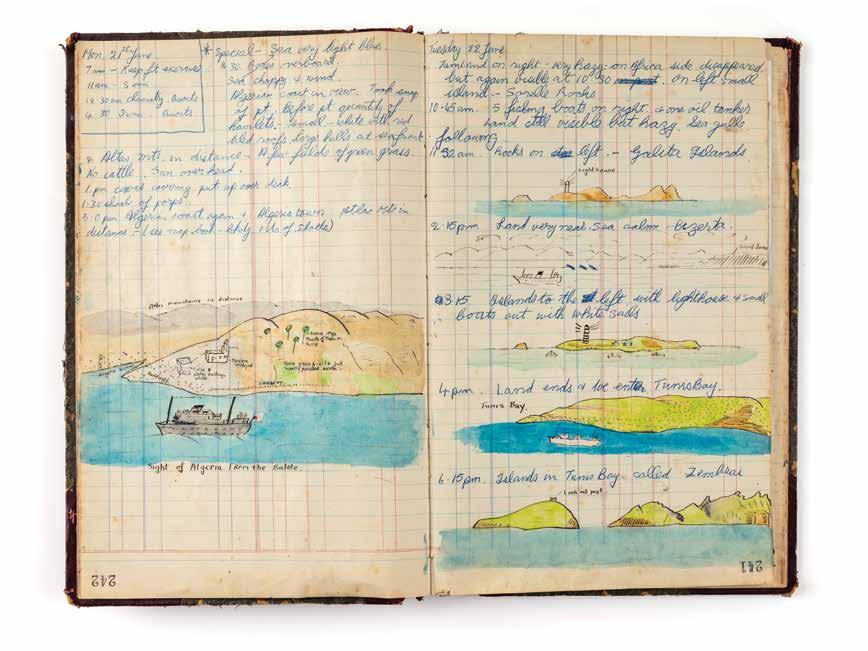

The family paid the fares of £110 each for Victor Snr and Sarah, and £50 each for Victor Jnr and Raymond (born 1942), and set to work packing. In June 1948, the Wilsons travelled by taxi from Bangor to Belfast Quay, where a large crowd of friends had gathered to farewell them with a parting hymn. The family boarded a steamer for the overnight crossing to the English port of Liverpool, making their way down the River Lagan past the Harland & Wolff shipyard, where RMS Titanic was built, out to Belfast Lough and into the Irish Sea.
In Liverpool, 16-year-old Victor Jnr sat for the London matriculation examination, with passes in mathematics, Latin and botany. On 16 June 1948 the Wilson family was among 234 passengers who embarked for Australia on the Burns Philp liner, Bulolo. As they sailed down the River Mersey, the Liverpool skyline and Royal Liver Building receding into the distance, Victor Jnr recalls, ‘We stood and gazed around us for the last time at the old country, mesmerised, almost in a trance as we suddenly realised we were on our way’.
Victor Jnr, who turned 17 on board Bulolo, kept a daily journal of the five-week voyage to Australia. In an old ledger book that his father used for patient prescriptions, Victor recorded details of port calls, bouts of sunburn and seasickness, and shipboard entertainment. On one occasion, his five-year-old brother Raymond won first place in an obstacle race, collecting a prize of £2 and a box of sweets. Victor also documented Bulolo ’s route from Liverpool to Gibraltar, Valletta, Port Said, the Suez Canal, Aden and the Indian Ocean.
On 17 July 1948 Bulolo docked in Fremantle, Western Australia, where officials boarded for mandatory passport and medical checks. The Wilson family made a day visit to Fremantle and Perth, before returning to the ship for the final leg of their voyage east. On the morning of 24 July, Bulolo arrived in Sydney Harbour, passing beneath the Sydney Harbour Bridge and berthing at Pier 4 Walsh Bay.
The Wilsons found temporary accommodation in a boarding house on Macleay Street, Kings Cross (known as ‘The Cross’). Victor Jnr recalls how his mother Sarah remarked, ‘You must always start at the Cross if ever you hope to reach home (that is, heaven)!’ The family’s first days in Australia were spent searching for a permanent home, while Victor Snr also went to the Pharmacy Board of New South Wales to register as a pharmacist. After a desperate week had passed, Victor Jnr remembers:
Mum had grown weary of roaming the streets of the city and suburbs looking for suitable digs. She said we have got to go home! Dad said we should pray as we thought of our predicament and he too had reached an end of his searching. As he prayed I could hear Mum sobbing, with tears rolling down her cheeks. When he finished all seemed to be calm. Then Dad said we shall go out this afternoon and see Mrs Boyd at Concord.

02 The family took a train from the city to Strathfield and walked the last few kilometres to Mrs Boyd’s house on Empire Avenue. Victor Jnr recollects:
We walked up the path and Dad rang the bell, expecting an elderly woman to come to the door. The door opened and a middle-aged woman came. We looked at her and Dad enquired, ‘Does Mrs Boyd live here?’ She paused and asked, ‘Are you the Wilsons? We were expecting you here a week ago and you did not turn up! Mrs Boyd has taken ill and has gone to live with her sister in Ararat, Victoria, and she has left the house for you if you wish to purchase it’.
Well we were dumbfounded. We had reached the end of our tether, as we say in Ulster, and now the provision of a lovely home was graciously presented to us by our Heavenly Father. Dad had no hesitation in being on the solicitor’s doorstep at 9 am Monday morning with the cash of £2,500 and the house was ours – praise the Lord.
In Sydney, Victor Wilson Jnr passed an entrance examination at the start of the final school term and enrolled at Fort Street Boys High School in Petersham. In 1957 he graduated from the University of Sydney with a Bachelor of Medicine and Bachelor of Surgery. He spent two years as a medical officer at St George Hospital in the southern Sydney suburb of Kogarah, followed by 18 months as an anaesthetist at the Brisbane General Board of Hospitals.
‘We stood and gazed around us for the last time at the old country, mesmerised, almost in a trance as we suddenly realised we were on our way’
Raymond Wilson attended Homebush Boys High School and then, like his older brother, completed a Bachelor of Medicine and Bachelor of Surgery at the University of Sydney. He was a medical officer at Royal Prince Alfred Hospital before moving to the United Kingdom, where he gained his fellowship in surgery. Raymond later returned to Sydney and gained his Australian fellowship. Brothers Raymond and Victor Jnr then worked in partnership for 30 years as medical practitioners in the southern Sydney suburb of Blakehurst.
Victor Wilson Snr was a chief pharmacist in Sydney’s west, firstly at the old Liverpool State Hospital and Asylum, and then at the newly built Liverpool Hospital across the road. He never missed a day of work in 25 years. Sarah Wilson was a homemaker; she and Victor Snr remained in Concord for the rest of their lives. Mrs Boyd had given them a place to call home.
Reflecting on his family’s life in Australia, Victor Jnr says:
Day by day, every movement in life was met with the word ‘welcome’. Some years after our arrival in Sydney, and with growing family life, we decided to have our names inscribed on the Welcome Wall as a way of saying thanks for the wonderful welcomes and openings presented to us in every aspect of life in this sea-girt land of Australia. Yes Dad’s deep faith was rewarded and today all our family are recipients of the fruit of his faith.

To me, preserved historic ships, if they are exhibited with imagination, are the cathedrals of the sea …
Frank George Griffith Carr, Director of the National Maritime Museum, Greenwich, England (1947–1966)
SO BEGINS HARLEY STANTON’S 20-YEAR JOURNEY TO find his own cathedral of the sea – a picture of the three-masted clipper ship Conway that carried his ancestors to Australia in the 19th century.
In the early 1850s, Stanton’s great-great-grandfather, Thomas Stanton, emigrated with his wife and four children from a small farming community located near Cambridge, in England’s east. They settled in Van Diemen’s Land, now Tasmania, where Harley Stanton resides today. Stanton’s quest for an image of the Conway was sparked by a discussion at a family reunion in 1999. What followed was an extensive search through museums, libraries and archives across Australia and around the world, which led him to uncover a much bigger story.
In My Cathedral in the Sea: A History of the Conway, Stanton presents an intersecting story of people and places through a close reading of ship’s logs, newspapers and passenger accounts. The book traces the history of the 1,168-ton Conway from its 1851 construction by Owens and Duncan in Saint John, New Brunswick, in Atlantic Canada, to its final resting place near the Sargasso Sea (in the North Atlantic Ocean) in 1875. Stanton notes that the ship possessed a number of distinctive features for its time, including a generous space of eight feet six inches (2.6 metres) between its two decks and modern lifeboats that could be lowered in less than a minute. In 1860 the secretary for the Emigration Board in London described Conway as a ‘most eligible vessel’. My Cathedral in the Sea is divided into 10 chapters that set the scene about 19th-century emigration, passenger travel and life at sea, before examining Conway ’s role on the Australian run. An early chapter explores the history of shipbuilding in Saint John, one of the largest shipbuilding ports in the world due to the abundant forests of Canada’s Maritime Provinces. Stanton has sourced a rich collection of photographs, engravings and lithographs depicting Saint John’s shipyards and shipbuilders, which evoke this era of wooden ships and iron men.
In 1853 Conway was sold to the Liverpool-based Black Ball Line, a name that became synonymous with fast passages from England to the Australian colonies during the age of the clipper ships. Between 1854 and 1862, Conway made five voyages under charter to the Emigration Commissioners, carrying a total of 1,980 free settlers to the colonies. Stanton dedicates a chapter to each crossing, which had an average duration of 98 days. The chapter on the 1854 voyage from Liverpool to Melbourne is particularly intriguing – a fatal cholera outbreak just one day into the journey forced the vessel to be quarantined in Greenock, Scotland, and Geelong, Victoria. Stanton provides a thorough treatment of disease and quarantine in the 19th century, which is not surprising given his background as a former health professional with the World Health Organisation.
The book contains useful appendices on Conway ’s owners, masters and surgeons-superintendent, as well as extracts from Lloyd’s Log pertaining to the vessel’s movements over its 24-year career. Of particular interest is the parallel reading of two shipboard diaries written by passengers Anne Gratton and Fanny Davis in 1858, now held in the collections of the National Library of Australia and State Library of Victoria. The diary excerpts provide a fascinating insight into life on board Conway ’s second voyage to Melbourne.
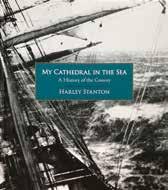
My Cathedral in the Sea: A History of the Conway
By Harley Stanton, published by Forty South Publishing, Lindisfarne, Tasmania, 2019. Hardcover, 222 pages, colour illustrations, index.
ISBN 978-0-6485328-9-7.
RRP $59.95 / Members $53.96
A welcome addition is the personal stories of some of Conway ’s passengers, such as Scotsman William Thomson, who arrived in Melbourne in 1854 and facilitated the migration of 1,000 youths through the Big Brother Movement; Englishman John Blundstone, who opened the Blundstone boot-making firm in Hobart Town in 1878; and English social reformer Maria Rye, who brought 140 educated young women and domestic servants to Moreton Bay in 1862. Miss Rye, a proponent of female middle-class emigration, would later turn her attention to philanthropic child migration schemes, sending 5,000 British children to Canada between 1869 and 1896. One notable absence in the personal stories, however, seems to be the author’s own ancestors – the social historian in me is left wanting to know more about the fate of Thomas Stanton and his descendants in Tasmania.
Overall, My Cathedral in the Sea is a fine example of what can be achieved from a detailed reading of historical records. It is a handsome and professionally produced self-published volume that will appeal to those interested in Australia’s maritime and immigration history, 19th-century shipbuilding and the golden age of sail. Perhaps what is most remarkable is that the author is not a mariner, but demonstrates a meticulous approach to maritime research that must certainly attest to a 20-year labour of love. And despite not having found that elusive image of the Conway, Harley Stanton paints a vivid picture of this great ship of Saint John.
Reviewer Kim Tao is the museum’s curator of post-Federation immigration.
For further information, or to order a copy of the book with free postage in Australia, email the author at HarleyStanton7@gmail.com or use the order form available at theconway.squarespace.com

A SMALL PRIVATE EVENT was held at the museum on the evening of 15 March to mark the first anniversary of the shootings in Christchurch, New Zealand, which killed 51 people at Al Noor Mosque and Linwood Islamic Centre.
The event acknowledged the first anniversary of the event, remembered the lives lost in the attacks, many of whom were migrants, and expressed the museum’s support for the Muslim community and the actions taken to help combat Islamophobia since the attacks.
It was organised with the support of the Australian National Imams Council (ANIC) and the New Zealand Consul General in Sydney, and attended by representatives from the Muslim community, the New South Wales Jewish Board of Deputies, SBS, the Department of Home Affairs, Multicultural NSW, Settlement Services International and the Affinity Intercultural Foundation.
Museum staff of Muslim faith and their families were also invited. Museum friends from the Islamic Museum of Australia, the Immigration Museum in Melbourne and the Migration Museum in Adelaide joined in via WhatsApp.
During the moving evening, Imam Ibrahim Dadoun performed prayers for the deceased and read their names aloud. Mrs Ramia Abdo Sultan, Community Relations Advisor at ANIC, spoke about the need for sustained action to combat Islamophobia in Australia. The New Zealand Consul General, Mr Bill Dobbie, talked of New Zealand’s deep appreciation of Australian support in the aftermath of the attacks.
The museum’s rooftop was also illuminated with the New Zealand silver fern and an invitation to remember all those who died.
Paul McCarthy, Executive Manager, Governance & Corporate Strategy, who spoke on behalf of the museum at the event, says the attacks in Christchurch prompted the museum to convene a national meeting of Australia’s migration and multicultural museums. An alliance was formed which resulted in more than 50 actions to support social inclusion and community harmony to help combat Islamophobia. He says:
Given there is good evidence that the public trusts museums, we are confident that telling stories about diverse populations not only provides a more rounded view of Australia, it also breaks down barriers and encourages conversation, reflection and understanding.
In its role of sharing stories of migration to Australia, the museum has created many opportunities for visitors to learn about Australian–Muslim history, which predates European settlement, in its exhibitions.
Recently the museum has also taken other initiatives, such as recruiting Arabic-speaking volunteers, screening the Islamic Museum of Australia’s film Boundless Plains in the theatrette and supporting the making of a tapestry rug by artists Sayd Abdali and Jane Théau for Refugee Week in 2019.
Rest George, may the seas open in front of you and may your sails be always billowing.1
IT IS A GREAT SADNESS that in late February, the museum lost one of its highly valued volunteers, George Bambagiotti. George was a popular guide and dedicated modelmaker. A retired graphic designer, he was acknowledged for his superb technical skill, forensic attention to detail, steady hand and aesthetic sensitivities.
George joined the museum after he happened to pass the modelmakers’ bench on a museum visit in 2005. Col Gibson was on volunteer duty that day, making a model of the schooner Mercury, when George asked, ‘How do you get a job like that?’ There it began, and while he waited for a vacancy on the bench, George began guiding visitors around the museum and its ships, in particular the HMB Endeavour replica.
George enjoyed guiding so much that he continued guiding visitors on Endeavour as well as modelling, until his health was no longer up to it. His knowledge of Endeavour, the essence of its timbers, tree-nails, sails and tales he then transferred to the world in miniature, quietly working on models at the bench, gently confiding his secrets to visitors.
His many projects included building models from scratch, such as Horatio Nelson’s famous HMS Victory, and rescuing and completing partially built models, including those of a Sydney harbour ferry and the legendary clipper Cutty Sark.
One of George’s biggest challenges came courtesy of Col Gibson in 2008. Could he complete a model of Herzogin Cecilie, the celebrated four-masted bark that Gustaf Erikson bought for the South Australian grain trade?
After an inspection in Gosford, north of Sydney, George took the metre-long 1:96 scale model home to his ‘shipyard’ – the family garage. There he patiently stripped paint from the hull and slowly repainted and built the ship from the hull up, crafting a new charthouse and miniature deck equipment to represent the vessel in its prime in 1935.
During George’s bouts of ill health, the project continued with the expertise of other members of the modelmaking team: John Laing, Janos Nemeth and Col Gibson. The hull, with lower masts stepped and deck fittings and fixtures nearly complete, now awaits new hands to fashion its rigging. That will see this fine model complete, a fitting tribute to George Bambagiotti.
Meanwhile, later this year, George’s model of Sydney ferry Sirius will be exhibited at the modelmakers’ bench when it is restored to the museum’s new Harbourside Observatory.
The museum, all staff and volunteers pay respect to George, his wife Lyn and their family. He will be sadly missed by all, especially his band of brothers – expert modellers John, Janos and the indomitable Col Gibson, who first enthused George about modelling. Farewell, George.
Daina Fletcher, Senior Curator

George Bambagiotti with the Herzogin Cecilie model in progress at the launch of the museum’s Windjammer Sailors sculpture and exhibition in November 2015. Image Andrew Frolows/ANMM
1 Email from fellow modeller Steve Adamantidis to Col Gibson, 9 March 2020. George Bambagiotti and others like him play a vital role in the museum’s activities and our visitors’ experiences. If you are interested in helping to honour George’s legacy by becoming a modelmaker, please contact the Volunteers manager, Thomas Devitt, on 02 9298 3777.
See Signals 110 (March–May 2015) for an article on fellow modelmaker and master mariner John Laing.
Acknowledgments
The Australian National Maritime Museum acknowledges the support provided to the museum by all our volunteers, members, sponsors, donors and friends.
The museum particularly acknowledges the following people who have made a significant contribution to the museum in an enduring way or who have made or facilitated significant benefaction to it.
Honorary Fellows
RADM Andrew Robertson
AO DSC RAN (Rtd)
John Mullen AM
Peter Dexter AM
Ambassadors
Christine Sadler
David and Jennie Sutherland
Major Donors – SY Ena Conservation Fund
David and Jennie Sutherland Foundation
Honorary Life Members
Dr Kathy Abbass
Robert Albert AO RFD RD
Bob Allan
Vivian Balmer
Vice Admiral Tim Barrett AO CSC
Maria Bentley
Mark Bethwaite AM
Paul Binsted
Marcus Blackmore AM
John Blanchfield
Alex Books
Ian Bowie
Ron Brown OAM
Paul Bruce
Anthony Buckley
Richard Bunting
Capt Richard Burgess AM
Kevin Byrne
Sue Calwell
RADM David Campbell AM
Marion Carter
Victor Chiang
Robert Clifford AO
Helen Clift
Hon Peter Collins AM QC
John Coombs
Kay Cottee AO
Helen Coulson OAM
Vice Admiral Russell Crane AO CSM
John Cunneen
Laurie Dilks
Anthony Duignan
Leonard Ely
Dr Nigel Erskine
John Farrell
Kevin Fewster AM
Bernard Flack
Daina Fletcher
Sally Fletcher
CDR Geoff Geraghty AM
Tony Gibbs
RADM Stephen Gilmore AM CSC RAN
Paul Gorrick
Lee Graham
Macklan Gridley
Sir James Hardy KBE OBE
RADM Simon Harrington AM
Chris Harry

Gaye Hart AM
Peter Harvie
Janita Hercus
Robyn Holt
William Hopkins
Julia Horne
RADM Tony Hunt AO
Marilyn Jenner
John Jeremy AM
Vice Admiral Peter Jones AO DSC
Hon Dr Tricia Kavanagh
John Keelty
Kris Klugman OAM
Jean Lane
Judy Lee
Keith Leleu OAM
Andrew Lishmund
James Litten
Hugo Llorens
Tim Lloyd
Ian Mackinder
Casimiro Mattea
Jack McBurney
Bruce McDonald AM
Ronald McJannett
Ron Miller
Arthur Moss
Patrick Moss
Rob Mundle OAM
Alwyn Murray
Martin Nakata
David O’Connor
Gary Paquet
Prof John Penrose AM
Neville Perry
Hon Justice Anthe Philippides
Peter Pigott AM
Len Price
Eda Ritchie AM
RADM Andrew Robertson
AO DSC RAN (Ret)
John Rothwell AO
Kay Saunders AM
Kevin Scarce AC CSC RAN
David Scott-Smith
Sergio Sergi
Mervyn Sheehan
Ann Sherry AO
Shane Simpson AM
Congratulations to Elizabeth Holgado-Vente, who won the Signals 130 caption competition with this entry: ‘Guess who won the fashion show!’
Peter R Sinclair AC KStJ (RADM)
Peter John Sinclair AM CSC
John Singleton AM
Brian Skingsley
Eva Skira
Bruce Stannard AM
J J Stephens OAM
Michael Stevens
Neville Stevens AO
Dr Andrew Sutherland AM
Frank Talbot AM
Mitchell Turner
Adam Watson
Jeanette Wheildon
Mary-Louise Williams AM
Nerolie Withnall
Cecilia Woolford (nee Caffrey)
Captain’s Circle Members
Dan Janes
Jonathon Casson
Mark Bethwaite AM
John Jeremy AM
Dawn Bradner
William Hopkins OAM JP
Louise Taggart
David Mathlin
Hon Margaret White AO
Arlene Tansey
Jeff Hughes
Judy Lee
Jaz Stephens OAM
David N Blackley
Peter Poland
Campbell Edmondson
Nick Yates
Martin Rathbone
Peter Dexter AM
Doyle Cook – Port Kembla Gateway
Paul Binsted
Dr Gary Holmes
Dr Anne Reekmann
Nigel Stoke
Honorary Research Associates
Lindsey Shaw
Jeffrey Mellefont
Paul Hundley
Rear Admiral Peter Briggs
Dr Ian MacLeod



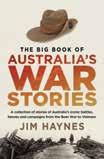




Captain Cook’s Epic Voyage by Geoffrey Blainey
Reveals the hardships, adventure and achievements of Cook’s most important voyage, challenging accepted views and examining the intersection of myth, science and exploration.
$35.00 / Members $31.50
The Dinosaur Book
This stunning kids’ encyclopaedia of the prehistoric world has everything you need to know about dinosaurs, pterosaurs, mammals and marine reptiles.
$39.95 / Members $35.95
Animal: The definitive visual guide
To tie in with our Wildlife Photographer of the Year exhibition, this new edition illustrates and explains the world’s incredible range of creatures.
$65.00 / Members $58.50
The Big Book of Australia’s War Stories
A unique collection of poignant, horrific, sad and sometimes dryly humorous stories and tales about wartime experiences of Australians on the front lines, in the air and at sea.
$35.00 / Members $31.50
Eco drink bottle Heart Reef design
Oasis stainless steel double-walled insulated drink bottle keeps beverages cold for up to 24 hours or hot for up to 12 hours. 500 ml
$28.00 / Members $25.20
Set of three canisters
Trio of canisters showcasing three tropical designs from the Sara Miller London Tahiti Collection, featuring beautiful gold detailing. Each tin 11 x 10 x 10 cm
$49.95 / Members $44.95

Members’ discounts Open 9.30 am–5 pm 7 days a week 02 9298 3698
Or shop online at store.anmm.gov.au
Authentic Aboriginal art
(5754) Bush Damper Seed
Oil on canvas by Geraldine Riley of Willowra, Tanami Desert. 106 x 68 cm
$599.95 / Members $539.95
(2564) Purukapali and Wai-ai
Natural ochres on canvas by Columbiere Tipungwuti of Tiwi Islands. 60 x 60 cm
$599.95 / Members $539.95
(5613) Spirit Women
Oil on canvas by Jacinda Hayes of Alice Springs. 120 x 64 cm
$599.95 / Members $539.95
All artworks come with certificates of authenticity. View a wider selection at store.anmm.gov.au
Signals
ISSN 1033-4688
Editor Janine Flew
Assistant editor Laura Signorelli
Staff photographer Andrew Frolows
Design & production Austen Kaupe
Printed in Australia by Pegasus Print Group
Material from Signals may be reproduced, but only with the editor’s permission.
Editorial and advertising enquiries
signals@sea.museum – deadline midJanuary, April, July, October for issues March, June, September, December
Signals is online
Search all issues at sea.museum/signals
Signals back issues
Back issues $4 each or 10 for $30
Extra copies of current issue $4.95
Call The Store 02 9298 3698
Australian National Maritime Museum
Open daily except Christmas Day 9.30 am to 5 pm (6 pm in January)
2 Murray Street Sydney NSW 2000 Australia. Phone 02 9298 3777
The Australian National Maritime Museum is a statutory authority of the Australian Government
Become a museum Member.
Benefits include four issues of Signals per year; free museum entry; discounts on events and purchases; and more. Visit sea.museum or phone 02 9298 3646. Corporate memberships are also available.
ANMM Council
Chairman Mr John Mullen AM
Director and CEO Mr Kevin Sumption PSM
Councillors
Hon Ian Campbell
Hon Justice S C Derrington
Mr John Longley AM
Rear Admiral Jonathan Mead AM RAN
Ms Alison Page
Ms Arlene Tansey
Dr Ian Watt AC
Hon Margaret White AO
Australian National Maritime Museum
Foundation Board
Chairman Mr Daniel Janes
Director Mr Peter Dexter AM
Director Ms Arlene Tansey
Ex officio Chair Mr John Mullen AM
Ex officio Director Mr Kevin Sumption PSM
Mr David Blackley
Mr David Mathlin
Mr Tom O’Donnell
Dr Jeanne-Claude Strong
American Friends of the Australian National Maritime Museum
Hon Peter Collins AM QC (Chairman)
Mr Robert Moore II
Mr John Mullen AM
Mr Kevin Sumption PSM
Ms Sharon Hudson-Dean
Foundation sponsor ANZ
Major sponsors
Commonwealth Superannuation
Corporation
Nine
Port Authority of New South Wales
Sponsors
Challis & Company
Colin Biggers & Paisley
Department of Foreign Affairs and Trade
Evan Powis Entertainment
Laissez-Faire Catering
Lockheed Martin
National Geographic
Nova Systems
Sydney by Sail
Supporters
Australian Government
Ovolo 1888
Property NSW
Queensland Government
Queensland Museum Network
Royal Wolf
Shipping Australia Limited
Silentworld Foundation
Sydney Fish Market
Tyrrell’s Vineyards
TimeOut
Signals is printed in Australia on Hannoart Plus Silk 250 gsm (cover) and Hannoart Plus Silk 113 gsm (text) using vegetable-based inks.




